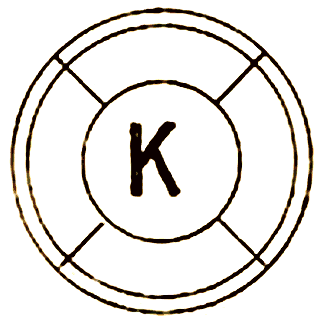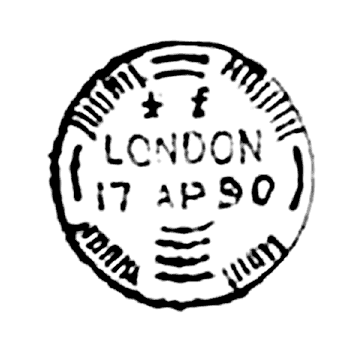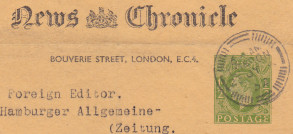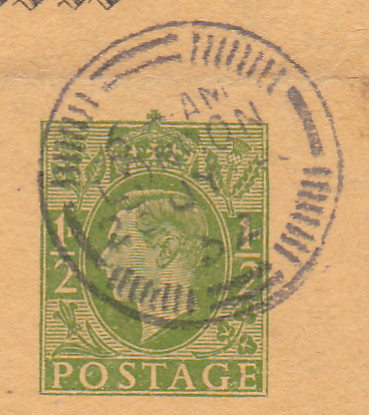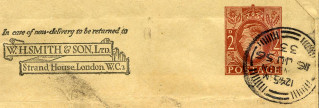Public Precancels
With the passing of the Post Office Act in 1870 implementing a cheap rate of ½d per 2 ounces for newspaper and circular postage, all but 'The Times' and the 'Stamford Mercury' elected to use normal stamped wrappers. Because of this, there was a sudden increase in the daily cancelling requirements.
The Post Office came up with a scheme whereby Publishers and News Agents sent in wrappers (addressed or un-addressed) early in the day for pre-cancelling, so they could then be taken back, sorted for the different routes and then used to enclose the papers when available to be put in mailbags and sealed by a Postal Official.
As an inducement, the pre-cancelled mail would be accepted for posting later than for ordinary mail.
This proposal was laid before the Provincial Newspaper Society during their annual meeting at the Crystal Palace on 10/5/1870 and accepted.
There was also provision when necessary for a post office clerk to take the pre-canceller to the customers' premises
to stamp the wrappers there.
The types illustrated below are generically referred to as 'milled edge postmarks' in English or 'Ailes de Moulin' (windmill wings) in French .
I was shown by Jan Kosniowski an article in 'Stamp Collecting' Magazine (14th January 1982) that appears to cover this subject quite extensively, including a table of 5 basic types and 20 sub-types giving sizes, dates and other information.
The article refers to a book
Newspaper and Almanac Stamps of Great Britain and Ireland, John H. Chandler & H. Dagnall (1981) which in turn refers to an article written on the subject by J. H. Chandler in GB Journal Volume 17, pp29-32 (1979) which shows the same illustrations and table as the magazine article. See below for these illustrations.
With kind permission of the Great Britain Philatelic Society (GBPS), I am reproducing here the illustrations and tabulated data they provide as it represents the most extensive work I have so far come across on this subject. Having said that, as will be shown, it is clear that there are mistakes in the work, possibly just typos that make it inconsistent. There is also evidence that some of the dates they give can be extended.
J. H. Chandler gives the following illustrations (I have added the Letaillieur equivalents in red, see below):
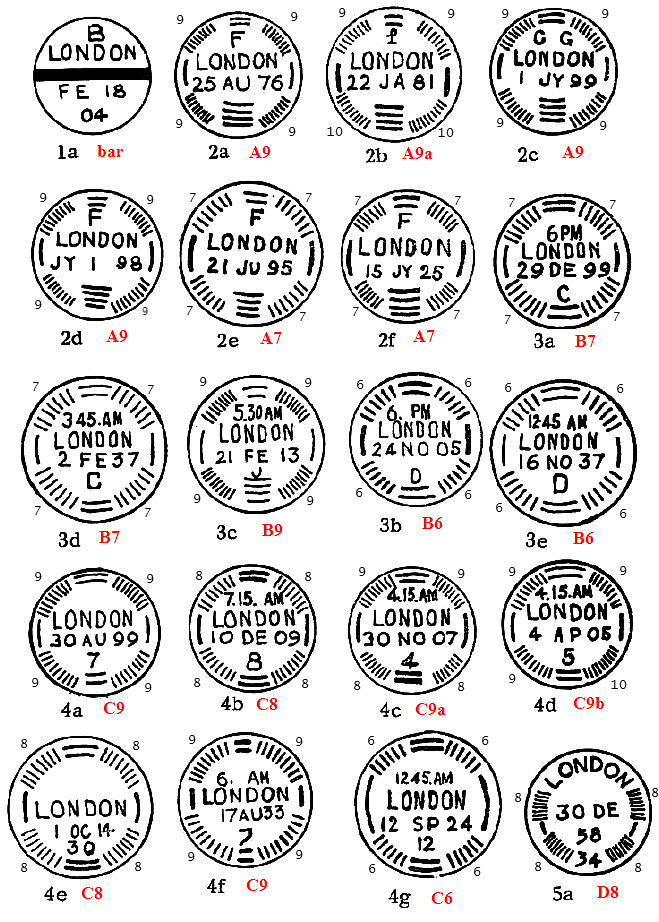
He classifies the milled edge postmarks into five groups and tabulates them as below:
| Type 1 | Barred circle, 'London' in upper semicircle |
| Type 2 | 'London' across middle; code letters above 'London' |
| Type 3 | 'London' across middle; code letters below 'London' |
| Type 4 | 'London' across middle; code figures below 'London' |
| Type 5 | 'London' round inside top of rim; code figures at foot of rim |
ML
# | row | Type | Bars | Diam. in mm
** | Time |
First issued | In use | Code
Letters & Figures | Notes
1,2,3,4 |
|---|
| Bottom | Radial* | From | To |
|---|
| Bar |
1a | 1a | | | 23 - 24 | None | | 1876 | 1905 | A |
|
| | 1b |
1aR | | | 23 - 24 | None | ? |
1976 |
1905 |
A, B |
16, 18 |
| | | | | | | | | | | | |
| A9 |
2 | 2a | 4 equal | 9, 9, 9, 9 | 25 | None | 8.10.70 | 1870 | 1901 |
C, E, F, G, H, I, K, f, h | 5, 22 |
| A9a |
3 | 2b | '' | 9, 9, 10, 10 | 26 - 28 | '' | | 1880 | 1890 |
f, g | 19 |
| A9 |
4a |
2c | '' | 9, 9, 9, 9 | 25 | '' | 26.1.83 | 1886 | 1902 |
Aa,CC,FF,GG,HV,II,MT,TT,bB,ab/dd,ff,gg,ii |
6, 7 |
| | 4b |
2cR | '' | 9, 9, 9, 9 | 25 | '' | ? | 1890 | 1895 |
ii |
6, 18 |
| A9 |
5 | 2d | 4 tapered | 9, 9, 9, 9 | 26 | '' | 12.2.84 | 1888 | 1907 |
C, D, F, H, g | 17 |
| A7 |
6 | 2e | '' | 7, 7, 7, 7 | 28 | '' | | 1891 | 1922 |
F, G, f, g |
8 |
| A7 |
7a | 2f | '' | 7, 7, 7, 7 | 26 | '' | | 1926 | 1927 |
F | 5 |
| A9b |
7b | 2g | ? |
10, 10, 9, 9 |
26+ | '' | ? | 1885 | 1885 |
F | 20 |
| | | | | | | | | | | | |
| B7 |
8 | 3a | 2 | 7, 7, 7, 7 | 27 | Clear | 5.9.99 | 1899 | 1929 |
A, B, C, E-I, K, L |
9, 10 |
| B6 |
9 | 3b | 2 | 6, 6, 6, 6 | 26 | '' | 5.9.99 | 1900 | 1923 | D |
11 |
| B7 |
10 | 3a | 2 | 7, 7, 7, 7 | 27 | '' | 4.5.05 | 1907 | 1935 |
A, B, C, E-I, K, L |
9, 10 |
| B9 |
11 | 3c | 4 | 9, 9, 9, 9 | 26 | None | 31.5.05 | 1913 | 1921 |
J |
9, 11 |
| B7 |
12 | 3d | 2 | 7, 7, 7, 7 | 27 | Clear | | 1935 | 1943 |
A, C, E-I, L |
9, 10, 11 |
| B6 |
13 | 3e | 2 | 6, 6, 6, 6 | 26 | '' | | 1937 | ? |
D |
12 |
| | | | | | | | | | | | |
| C9 |
14a | 4a | 2 | 9, 9, 9, 9 | 25 | Clear or none | | 1896 | 1915 | 1-7, 14 | 13, 14 |
| | 14b | 4aR | 2 | 9, 9, 9, 9 | 25 | Clear | | 1900 | 1900 | 3 | 18 |
| C8 |
15 | 4b | 2 | 8, 8, 8, 8 | 25 | Clear | 27.3.01 | 1902 | 1957 |
1, 2, 3, 8-13, 15-20, 31-40 | 14, 21 |
| C8 |
16 | 4b | 2 | 8, 8, 8, 8 | 26 | Clear or none | 5.8.02 | 1902 | 1920 | 1, 2, 8-13, 15-20, 31-40 |
14 |
| C8 |
17 | 4b | 2 | 8, 8, 8, 8 | 26 | '' '' | 20.2.07 | 1907 |
1941 |
1, 2, 8-13, 15-20, 31-40 | 14 |
| C9a |
18 | 4c | 2 | 9, 9, 8, 8 | 25 | Clear | | 1904 | 1907 | 4 | |
| C9b |
19 | 4d | 2 | 9, 9, 9, 10 | 24 | '' | | 1905 | 1913 |
1, 5 |
14 |
| C8 |
20 | 4e | 2 | 8, 8, 8, 8 | 28 | Clear or none | |
1912 |
1937 |
11, 21-30 | |
| C8 |
21 | 4b | 2 | 8, 8, 8, 8 | 26 | Clear, none or 'A' | | 1919 | 1959 | 1, 2, 8-13, 15-20, 31-40 |
14 |
| C9 |
22 | 4f | 2 | 9, 9, 9, 9 | 26 | Clear or none | | 1922 |
1937 |
5, 6, 7 | 23 |
| C6 |
23 | 4g | 2 | 6, 6, 6, 6 | 28 | '' | | 1923 | 1924 |
12, 13, 31 | |
| C6 |
24 | 4g | 2 | 6, 6, 6, 6 | 29 | 'A' or none | | 1949 |
1964 |
12, 13, 31 | |
| | | | | | | | | | | | |
| D8 |
25 | 5a | 0 | 8, 8, 8, 8 | 24 | None | | 1958 | 1966 |
10, 34 |
15 |
* Radial bars recorded in the order: top left, top right, bottom left, bottom right. Note that Letaillieur uses a different sequence.
** Chandler seems to be measuring outer-edge to outer-edge.
For comparison it would be better to measure centre to centre as it is more constant with under/over inking.
| My Notes on this Table: |
|---|
| 1. | The row numbering is my addition to simplify referencing. ML# (2nd. Column) is the Michel Letaillieur designation (see below). |
| 2. | The 'Code Letters/Figures were originally in a separate table, I moved them for ease of reference. |
| 3. |
The references to 'Clear' means 'Time in the Clear' or 'Clear Time' meaning human-readable (from 1895) as oppose to 'Time in the Code'. |
| 4. |
I have highlighted discrepancies. |
| 5. | Row 2, Type 2a. is generally tapered slightly, as much as type 2f (see the halfpenny reds illustrated). |
| 6. | Row 4, Type 2c. It is possible that one of the letters in each pair is actually 'Time in the code'. |
| 7. | Row 4, Type 2c includes the code 'ab/dd'. I take this to mean 'a b' over 'd d', but I could be wrong, and do not know what it would signify. |
| 8. | Type 2e measures from 26.5mm to 28mm in the examples I have (most 27mm - measured centre to centre of the line). Chandler says used up to 1921, I have October 1922. |
| 9. | As it stands, rows 8 & 10 (Type 3a) are indistinguishable and for that matter 3d on row 12 (for codes other than 'C').
Also on row 11, Type 3c has Clear time not 'None'.
I suspect row 10 should have been marked 'None' instead with rows 11 & 12 'Clear'.
|
| 10. | Type 3a measures less than 26mm, 3d measures 27mm. |
| 11. | In the postmark illustrations, 3b, 3c and 3d are out of sequence. This might have added a confusion factor. |
| 12. | Row 13 (Type 3e) is left with an open-ended date. |
| 13. | Type 4a illustration shows it as 'None' but row 14 says 'Clear' and I have 2 examples with 'Clear' so this should be 'Clear or None'. |
| 14. |
As it stands, rows 16, 17 & 21 are indistinguishable for 'Clear or none'. 4b seem to measure about 25mm ± ½mm whilst
4a and 4d measure about 24mm. Perhaps rounding to the nearest mm was a mistake.
Additionally it is not clear how the measurements are made (outer, inner, centre-to-centre). I have measured centre-to-centre.
I presume that not all 'Codes' exist in all sizes. |
| 15. |
Row 25, It was originally given as up to 1959, but I have a perfinned (OP) example of 5a dated 11th April 1966, so I have updated it.
James Mackay illustrates one (shown above) dated 15th September 1967 |
| 16. |
As described by Chandler for Type 2c below,
I have examples of reversed date for type 1a code 'A' (SP 17 87 and AP 7 94) and 4a code 3 (MY 10 00) also. All of my 1a code 'B' (from SP 28 78 to AU 26 04) are reversed. |
| 17. |
The illustration of Type 2d shows a 'reversed-date' example, but the only examples I have are normal. |
| 18. | I have added these rows to clarify 'Reversed date' types including my own examples, see Chandler's Note on type 2c below.
All the examples I have of code 'i i' are reversed date. |
| 19. | This originally said 1881, but I have an example on a 2½d blue dated 27 NO 80 (see below). |
| 20. |
I have added Type 2g at row 7b to cater for 10 radial bars at top-left. I only have two examples so far which do not show the bottom half. Michel Letaillieur however lists his type A9b as being 10, 10, 9, 9. |
| 21. | I have added Code 3 to Type 4b at row 15 because of a 1930s example I have. |
| 22. | 'K' Added to list due to examples. |
| 23. |
This was previously listed as 1924-1933, but a code '7' has been seen used on a stamp that was not issued until 1937 with a The Daily Telegraph Perfin.
This had time in the Clear. I have also seen a code 6 used 25 November 1922 with no time, so Time should be 'Clear or none' rather than simply 'Clear' as it was originally. |
| Chandler's Notes: |
| Type 1a, codes A and B. | These are the only codes known for this type and they do not appear to have been recorded for group 2.
They reappear in group 3 in 1899. The stamps of group 1 were in concurrent use with those of groups 2-4
over a long period, so it may be that the barred circles and the milled edge stamps of group 2 formed a single combined issue. |
| Type 2a, code C | This stamp seems to have been retained in use for odd jobs in the Foreign Section after the issue of this code in Type 2d. |
| Type 2a, code F | This seems to have been re-cut about 1876, with the top horizontal bars shortened. |
| Type 2b, code g | With later impressions the code letter gets so blurred as to form an almost solid rectangle, which can be mistaken for B, E, S or 8. |
| Type 2c, code ii (page 29) | I have a series used between June 1890 and November 1891, all with the month before the day and all on 1d stamps
which could perhaps indicate Late Fee use. Such reversed dates are much rarer than normal dates. |
| Some comments of mine: |
| 1 | The first note about 1a Codes A and B is partly undermined by 2c code 'Aa'. |
| 2 | The last of Chandler's notes refers to examples shown at the top dated DE 7 94 and OC 25 95 |
| 3 | Comparing Chandler's
work with the illustrations of James Mackay shown below raises some questions.
JM2303 - was this an essay that was rejected in favour of type 1a ?
JM2304 - this looks like type 2a but code 'L' is not listed by Chandler. Considering the date on it, is this another essay?
JM2308 - this looks like
type 4g for 1962 but without 'LONDON' and Chandler only lists codes 12,13 and 31 ???
JM2309 - this is type 5a, but Chandler gives a date range of only 1958 to 1959 (my only example is 1961). |
| 4 | I have added another column at the beginning headed 'ML#' to designate the Michel Letaillieur equivalent (see below). |
James Mackay illustrated these types, and many more.
He describes them as datestamps intended as cancellers
and incorporating an obliterating element.
See my comments above on these illustrations. |
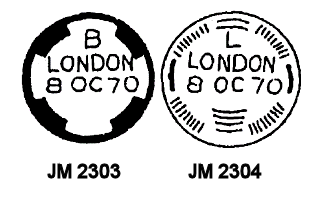 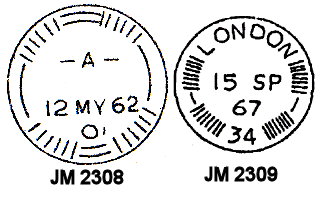
|
Comparison with James Mackay
James Mackay shows a number of examples, but I have chosen the ones shown above for their contribution to the information given by J. H. Chandler.
| JM2303 | This is dated 8 Oct 70 which corresponds to the 'First issued' date of 2a. Also Chandler does not show it.
This suggests it may represent an un-adopted essay. |
| JM2304 | This has the same date but clearly has '4 tapered' bars making it 2d which according to Chandler was first issued February 1884.
This is taken from the books of the Circulation Department for 27 October 1870 at the Royal Mail Archives at Mount Pleasant. |
| JM2308 |
This is like type 4g but does not have 'London' and so does not fit into this classification system! It puzzled me for a long time.
Thankfully Jan Smith sent me the illustration below that explains this illustration. Thanks Jan.
|
| JM2309 |
This is type 5a dated 15 Sept 1967 which well exceeds Chandlers 'To' date of 1959. Curt Fernau records some type used in 1969 however. |
This one appears to have a date 2 years later than the 1962 date previously recorded for Type C6 (4g).
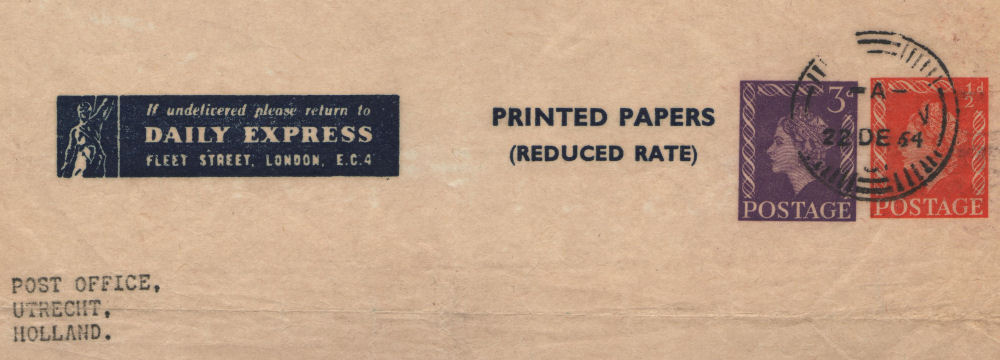

It shows the cause of James Mackay's illustration JM2308. "LONDON" and the code are almost missing.
Both of them should presumably have been code 31. Image courtesy of Jan Smith, active member of the Dutch precancel society.
Due to the shortage of complete examples, I have reconstructed what a complete one might look like, shown on the right.
I initially used the classifications of J. H. Chandler since they
are based on many more examples than I have and appeared suitable.
In the light of the discrepancies already noted however, and some apparent conflicts with the work of James Mackay, some verification is required.
I have recently learned of work done on the subject by Michel Letaillieur who wrote an article for the French 2012 conference of l'Académie de philatélie.
He uses a different classification system in an attempt to improve on work done by Stitt Dibden and J. H. Chandler.
I will describe his system below and compare it to that of Chandler:
actual examples whether confirming these tables or otherwise, would be very welcome.
| Type | Radial Bars | Codes | Usage | Chandler Equiv. | Notes |
|---|
| Group A all have 4 arcs at the bottom and codes at the top. |
| A7 | 7, 7, 7, 7 | F, G, f, g | 8/8/1891 - 31/3/1925 |
2e, 2f |
Chandler: 2e 1891-1921 (I have 1922), 2f 1926-1927. |
| A9 | 9, 9, 9, 9 | 1 or 2 letters, (
C, D, E, F, G, H, I, K, f, g, h
Aa,CC,FF,GG,HV,II,MT,TT,bB,ab/dd,ff,gg,ii) |
31/10/1870 - Aug 1903 | 2a, 2c, 2d | Code 'H V' (Holborn Viaduct) continued till Aug.1905 |
| A9a | 9, 9, 10, 10 | f, g | | 2b | |
| A9b | 10, 10, 9, 9 |
F |
| Not listed, I added 2g | |
| |
| Group B all have code letters at the bottom. |
| B6 | 6, 6, 6, 6 | D | 24/4/1900 - 3/1/1923 | 3b, 3e | |
| B7 | 7, 7, 7, 7 |
Letters (A, B, C, E-I, K, L) |
5/6/1900 - 11/4/1940 | 3a, 3d | Code letters initially 2.5mm font increasing to 3.5mm 1935 |
| B9 | 9, 9, 9, 9 | J | 1/11/1902 - 20/7/1921 | 3c | B9 has 4 arcs at the bottom, the rest of the group has 2. |
| |
| Group C all have code numbers at the bottom. |
| C6 | 6, 6, 6, 6 |
12, 13, 31, 37* |
7/10/1922 - 18/9/1961 | 4g | |
| C7 | 7, 7, 7, 7 | 3, 4, 8 |
†18/11/1921 - 23/7/1929 |
Not listed |
Earliest date was originally given as 11/1/1922. |
| C8 | 8, 8, 8, 8 |
numbers 1 to 40 |
3/5/1901 - 6/11/1957 | 4b, 4e |
Chandler says codes: 1, 2, 8-13, 15-40 (I found 3) |
| C8a | 8, 7, 8, 8 | 37 ? | | Not listed | |
| C9 | 9, 9, 9, 9 | numbers 1 to 15 | 12/12/1896 - 16/10/1946 | 4a, 4f |
Chandler says codes: 1-7, 14 |
| C9a | 9, 9, 8, 8 |
4 |
| 4c | |
| C9b | 9, 9, 10, 9 | 1, 5 |
|
4d |
Chandler calls this 9,9,9,10 due to different ordering. |
| |
| Only the one member of this group. |
| D8 | 8, 8, 8, 8 | 10, 34 | 7/10/1922 - 18/9/1961 | 5a | |
| |
| Only the one member of this group. |
| Bar | None | A, B | | 1a | |
| My comments (mostly not criticisms): |
|---|
| 1 | Radial bars recorded clockwise from top left. Different to Chandler. |
| 2 |
† The dates given are usually from examples he has seen and are minimum ranges. |
| 3 | Both letters and numbers are included in the same types, letters were used first and numbers later. |
| 4 | * C6 code 37 is illustrated with an example that may be 31. |
| 5 | No distinction is made between '4 tapered' and '4 equal' arcs. |
| 6 | It does not address the fact that dates are sometimes 'D M Y' and sometimes 'M D Y'. |
| 7 | It ignores minor differences such as diameter and time format. |
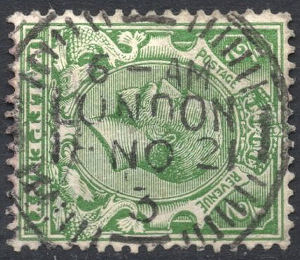
† A good example of a C7 code 3 dated 18 November 1921 courtesy of Dave Finch.
The earliest date previously given for a C7 was 11/1/1922.
| Cross-Reference List |
|---|
| Chandler | Letaillieur |
|---|
| 1a |
Bar |
| 2a |
A9 |
| 2b |
A9a |
| 2c |
A9 |
| 2d |
A9 |
| 2e |
A7 |
| 2f |
A7 |
| 10, 10, 9, 9 |
A9b |
| 3a |
B7 |
| 3b |
B6 |
| 3c |
B9 |
| 3d |
B7 |
| 3e |
B6 |
|
| Chandler | Letaillieur |
|---|
| 4a |
C9 |
| 4b |
C8 |
| 4c |
C9a |
| 4d |
C9b |
| 4e |
C8 |
| 4f |
C9 |
| 4g |
C6 |
| 7, 7, 7, 7 |
C7 |
| 8, 7, 8, 8 |
C8a |
| 5a |
D8 |
|
Chandler did not list equivalents for Letaillieurs' types A9b, C7 and C8a.
Until now my designations given have been given in the old system. However I cannot ignore the more recent work done on the European mainland.
I therefore need to revise this page and my database to include all the information I have.
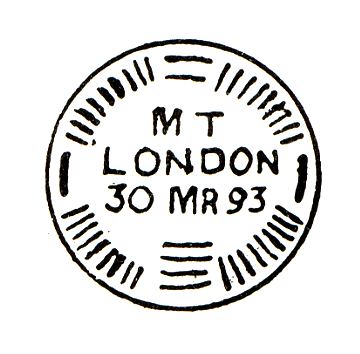 |
Dr. J. T. Whitney in Collect British Postmarks describes this as:
'London Circular marks with side shading'.
I know that the code 'H V' was used on these for Holborn Viaduct.
Anyone know what 'M T' might have meant ? |
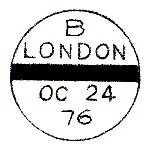 |
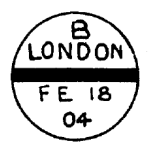 |
R.C. Alcock and F.C. Holland have the same illustration as Dr. J. T. Whitney
above, but their description is:
'For pre-cancelling the wrappers of certain large newspapers and newspaper
distributing agents [this] type was introduced in the 1870s, and varieties exist from then
until the present time.
There is also a special variety with a thick horizontal bar as diameter, only the date
below and "LONDON" and a letter above.' - see illustration at left. |
| after James Mackay |
after J. H. Chandler |
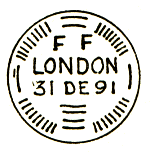 | George Brumell gives the illustration on the left and says:
'The peculiar design of [this] is used in London on printed matter, probably chiefly,
if not entirely to pre-cancel wrappers used by the great paper-distributing agencies.'
- But see also the high value usage below. |
So, two great names say that these types were used as precancels. The others do not disagree although not stating a precise purpose.
The important thing here though is that whereas the earlier precancels were in the keeping of private firms for their own use (in theory at least),
these types appear to have been in the possession of the post office(s) for more-or-less general use.
Because of this I will use the term 'Public Precancels' to describe them.
The existence of these marks on high-value stamps suggests that they were also used to send multiple circulars / newspapers
for local distribution in shops or by hand. Below is a Type C9 (4a) code 1 on an 1884 2s6d in 1897,
a A9(2c) code 'A a' used in 1893,
and a Type A9(2c) code 'A a' used on an 1884 5/- stamp offered by Shaun Taulbut on eBay.
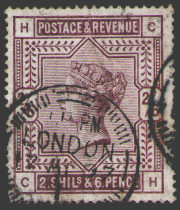

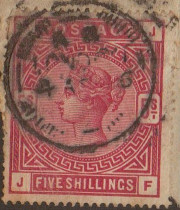
Below are two wrappers with what appears to be the same type of milled edge Precancel C8(4b).
The 'News Chronicle' image is courtesy of Thomas P. Myers (Editor of Great Britain Collectors Club (GBCC) ), it has an unclear year,
but the ½d was changed to orange in 1951.
The W. H. Smith wrapper is courtesy of Jan Kosniowski who thankfully brought this issue to my attention!
It bears a 2d brown used in the reign of Elizabeth. The Elizabethan wrappers were not available until 1956 (Huggins & Baker).
This 'Stubbs' Weekly Gazette wrapper was laid on top of the previously pre-cancelled wrapper and ink picked up from that shows through to the front of this!
It has a type B7(3a) code B milled edge postmark dated 27th February 1901 measuring 26.5 mm
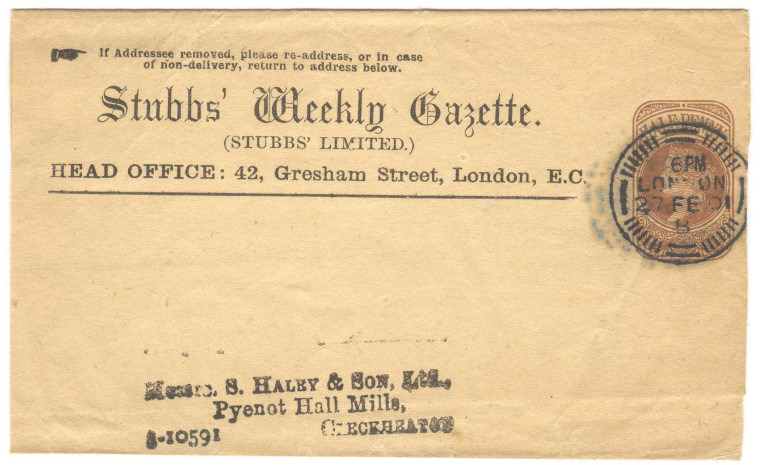
Here is an earlier one dated 6th May 1885 with Type A9(2a), code 'h'.
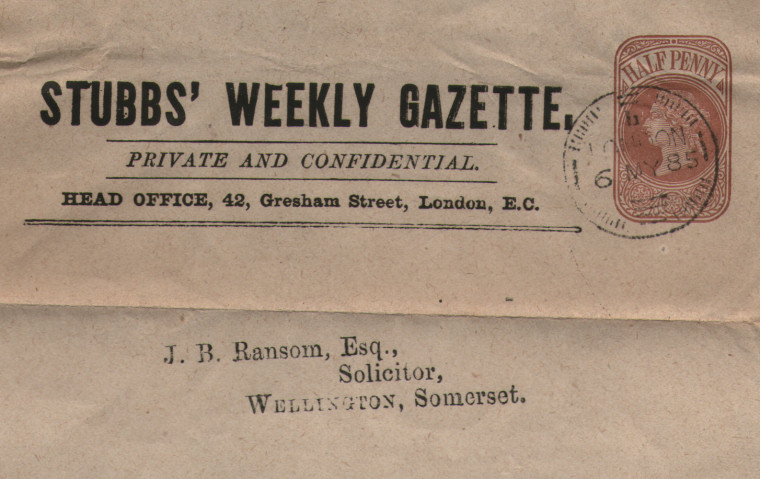
This Daily Mail (part) wrapper with type A9(2c) code I I dated 9 SP 02 also has an offset on the back.
I also have a complete wrapper type A9(2c) code I I to Bucharest, Rumania but a bit tatty, dated 6 SP 01 with an offset.
Note that this was addressed to Holland, so these precancels were used for foreign mail also.
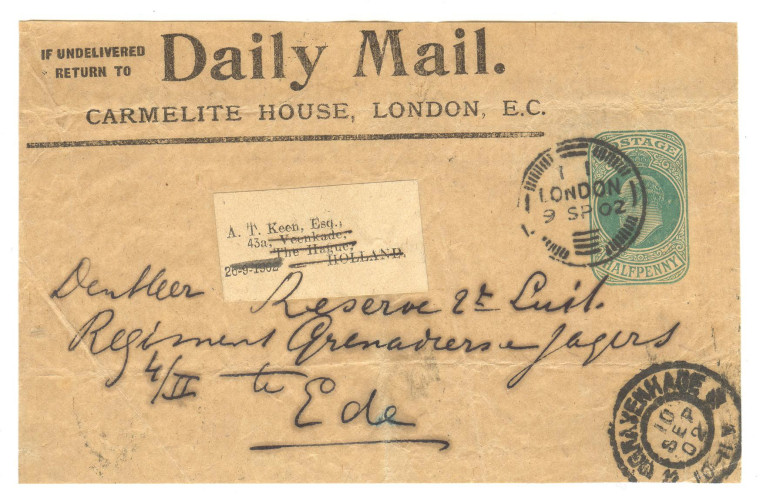
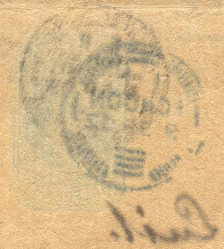
This one to Germany 18 months later (21 MR 04) has type C8(4b) code 9 (25mm) has an offset showing through to the front.
The Daily Mail was first published in 1896 so the milled edge precancels were probably the first type they used.
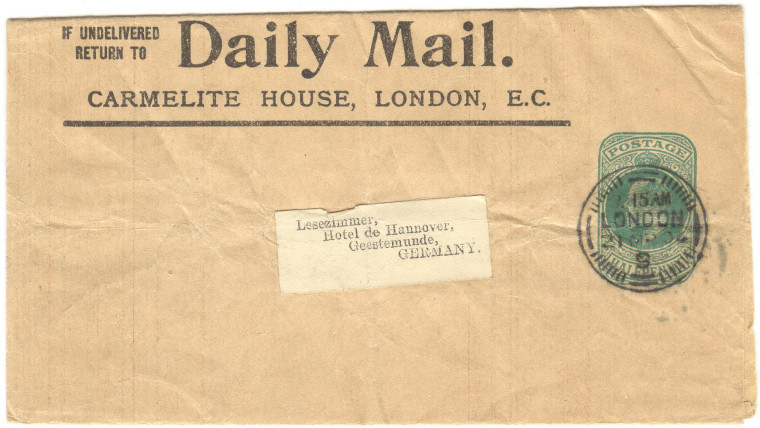
This Homeward Mail (part) wrapper with type A9(2a) code F dated 4 SP 71 used on ½d red plate 8 also has an offset.
It was used by Henry S. King & Co. to distribute copies of the 'Homeward Mail' weekly.
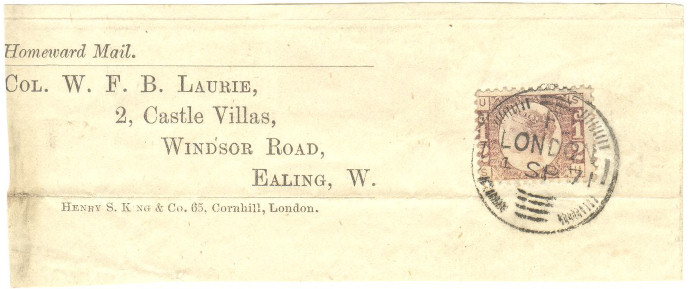 |
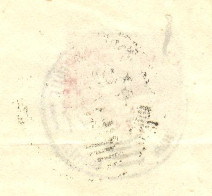 | 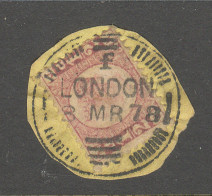 |
| Reverse showing an offset. |
Another ½d red (1878 plate 14) with Type A9(2a) code 'f'. |
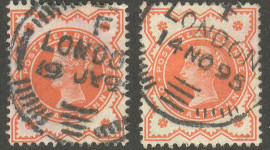
Type A7(2e) codes 'F' and 'f ' for comparison of bar-tapering with 2a above.
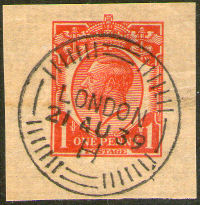
Type B7(3d) code 'H'.
This W. H. Smith & Son wrapper with Type C9(4a) code 4 dated 4th January 1905 also has an offset on the back.
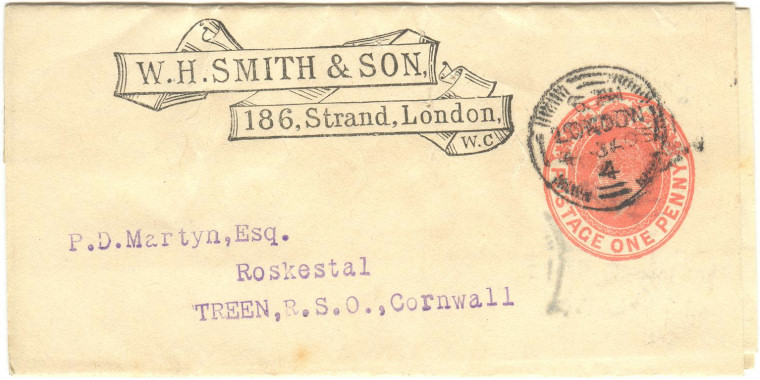
Here we have a couple of WHS wrappers both with Type C8(4b) code 33 cancels, both addressed to Miss Essex.
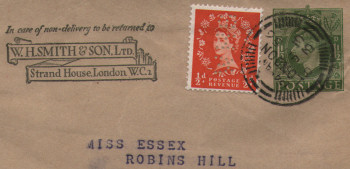
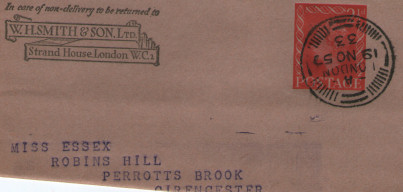
The 1956 cancel (note the perfin) has 'time in the clear' whereas the 1957 cancel has '- A -' in place of it. Both code 33.

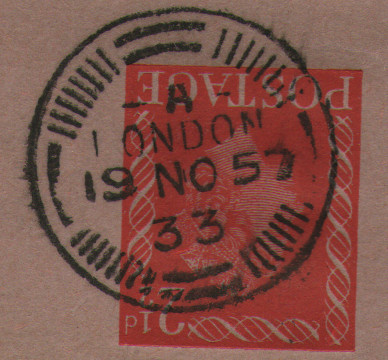
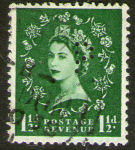
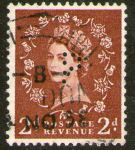
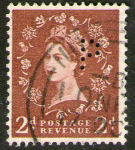
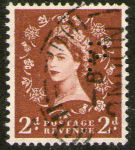

Chandler lists the '-A-' time-code used with types 4b and 4g (C8 and C6) but date-code '-B-' was also used.
Jeff Turnbull has supplied me with a list of a dozen users of this 'P' perfin. in London.
To me, the most likely of them to also need precancels is "The People" newspaper published by Oldham Press Ltd. Long Acre, and 222 Strand, London WC2.
A W. H. Smith & Son wrapper with a rather smudgy Type C8(4b) code 34 (25 mm) dated 30 August 1953 has no discernible offset on the back.
Pencilled on it is "People's Friend", the name of a weekly magazine founded in 1869.

This W. H. Smith & Son part wrapper with Type C8(4b) code 38 (25.5 mm) dated 22 June 1948 does have an offset on the back.
(The George VI 3d die was not available until 1951).
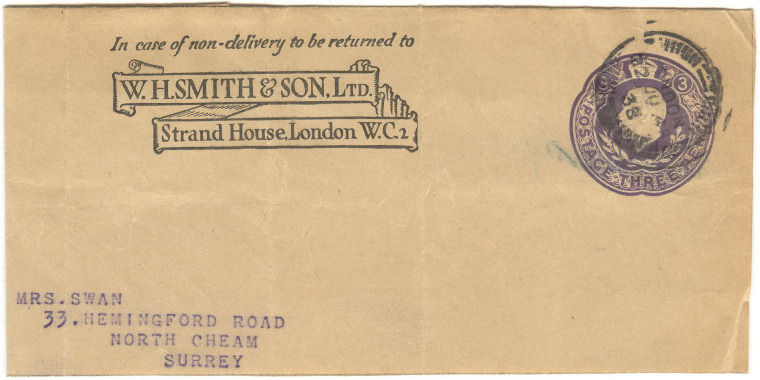
This King George VI part wrapper dated 10 March 1960 has a Type D8(5a) code 34.
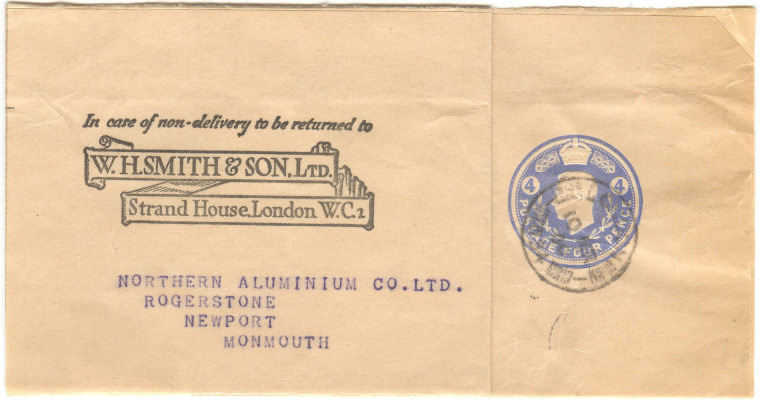
These are two pieces with stamps perfinned with the 'WHS' of W. H. Smith & Son cancelled with Type D8(5a).
The one on the left is code 10 dated 3rd March 1960. The other is unclear but possibly 4th February 1963, unknown code.

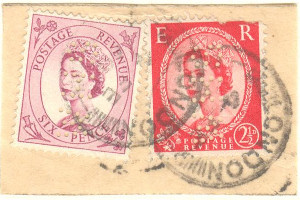
This one has an earlier date than previously recorded for Type C8 (4e) code 11
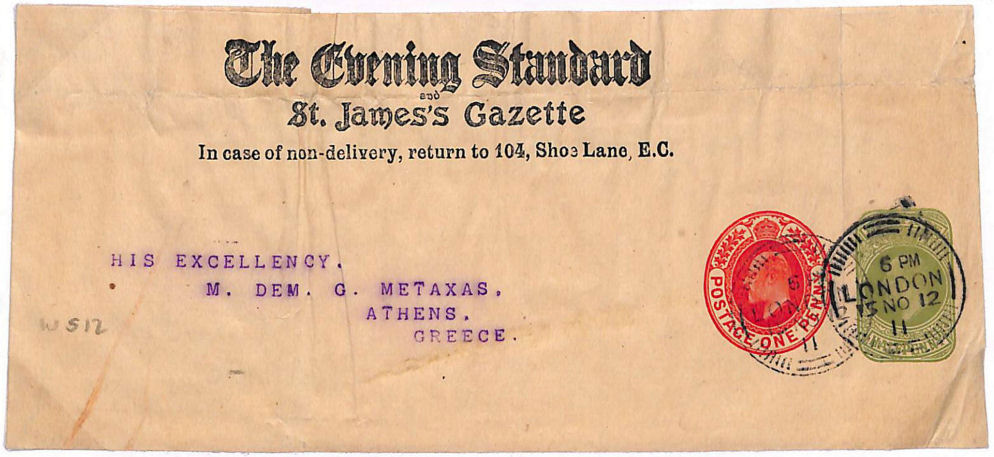
It seems to actually be somewhere between 4b and 4e going by Chandler's illustrations. Courtesy of Samwells Ltd.
An interesting use of type C8(4b) code 2 to cancel a First-Day cover.
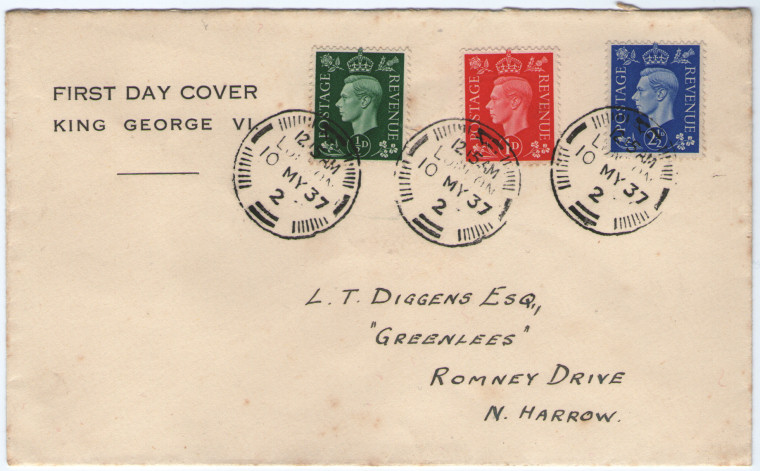
An example of what appears to be private usage of type A9(2c) code 'H V' can be seen at l'Académie de philatélie.
I have seen on eBay a lot which included 7 examples of Type C8(4b) all on ½d KEVII stamps in the date range December 1904 to April 1905.
The legible ones all have a time of 7.15am, and are perfinned with 'DX' (Daily Express). 2 of them have code 9 and 5 have code 13.
They seem to measure about 25mm diameter for code 9 and 26mm for code 13.
This perfin relates to The Daily Express, St Bride St, London EC.
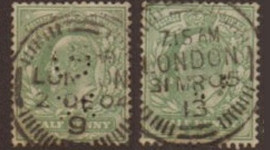
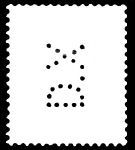
I have acquired a total of 32 examples (from the same source in Germany) of Type C8(4b) all on ½d KEVII stamps in the date range September 1906 to November 1908.
They all have a blank time, and are perfinned 'L & P'. Sixteen of them have code 11, fifteen have code 12 and one (10 NO 08) has code 15.
They measure about 26mm diameter.
I believe that the perfin relates to London & Paris Exchange Ltd., of Moorgate Street, London EC3.
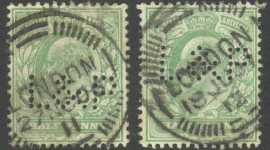
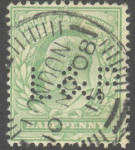

 |
 |
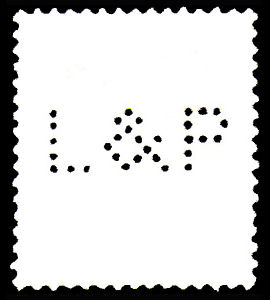 |
 |
| L4380.03M |
L4380.03a |
L4380.03b |
L4380.04a |
It turns out that my initial approach to these was overly simplistic. There are (at least) 7 different dies used for this perfin.
Jeff Turnbull has been a great help on these. The four above, are known to have been used with the milled-edge precancel, and possibly more were.
The code 'M' on the first one means a 'multi headed' die. This means from 2 to 12 heads are punching in one operation.
With a single heads, the punching was very laborious and sheets were often folded so several layers were punched in one operation.
This led to all combinations of inverted/reversed perfins.
London & Paris Exchange were very prolific perfin users and a multi headed die made things quicker and easier.
Such a die had anything from 2 to 12 heads, and there could be minor variations between them.
The distinguishing feature on this is the wide top loop to the '&'.
3b differs from 3a in that the gap between 'L' and '&' is bigger in 3b.
4a is taller and (because the last hole of the '&' is missing) narrower.
For Perfinned Precancels, here is an excellent article, well worth a read by the Perfin Society.
I have a batch of Type C8(4b) code 10. Two are halfpennies dated 1905 with 'L & P' perfins,
7 are 1½d dated from 1902 to 1910 (one with a 'T' perfin of 'Tribune Rendezvous'), and one is a 3d dated 28 May 1916.
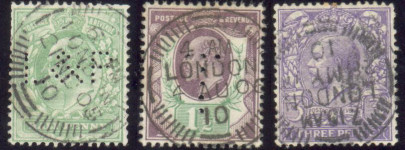
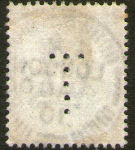
I have also acquired a dozen examples of Type C8(4b) all on 1d KGV stamps in the date range 1st November 1913 to 31st December 1913.
The legible ones (9 out of 12) have the time 3.45am., and the legible ones (10+ out of 12) have code 9. They measure about 25.5mm diameter.
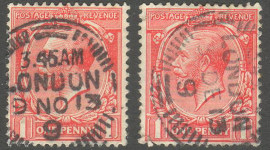
Perfins found on Milled-Edge precancels:
Examples that I have, including the three above.
Virtually all the information on these comes from the Perfin Society / Jeff Turnbull.
The ones with mauve background are completely from that source. Thanks Jeff !
Orange is other contributors, primarily Dan Baugher.
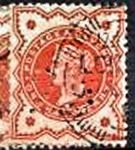
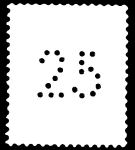 |
| My Reference |
N25-1 |
| Perfin Soc. Ref. |
0190.01 |
| Perfin User |
Unknown |
| Precancel Types: |
C9/4a code 1 |
| Date range: |
1895-1900 |
|

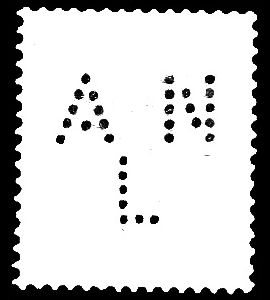 |
| My Reference |
ANL-1 |
| Perfin Soc. Ref. |
A4230.02 |
| Perfin User |
Associated Newspapers Ltd.
Northcliffe House,
London, EC4. |
| Precancel Types: |
C9 code 6 |
| Date range: |
16/5/05 to 28/11/11 and c1930 |
|
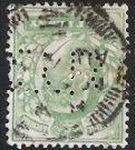 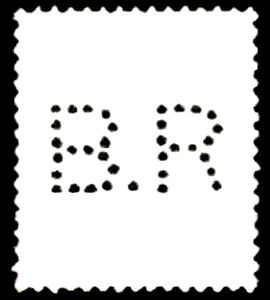 |
| My Reference |
BR-1 |
| Perfin Soc. Ref. |
B6110.02 |
| Perfin User |
Brasch & Rothenstein, Forwarding Agents,
44a & 45 Fore St, London EC. |
| Precancel Types: |
A9 code HV (Holborn Viaduct) |
| Date range: |
1900 - 1915 |
|
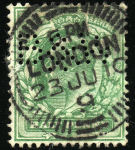
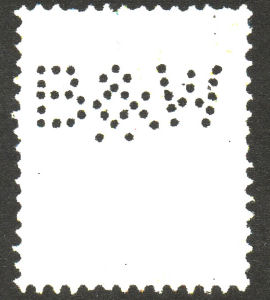 |
| My Reference |
BW-1 |
| Perfin Soc. Ref. |
B7585.01M |
| Perfin User |
Unknown |
| Precancel Types: |
C8 code 9, 12 |
| Date range: |
5/10/01 to 2/9/1910 |
|
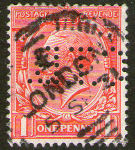
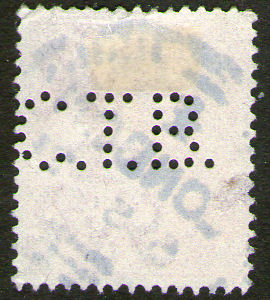 |
| My Reference |
CTB-1 |
| Perfin Soc. Ref. |
C7550.01 |
| Perfin User |
Commercial Telegram Bureau.
(was also a publishing company) |
| Precancel Types: |
A7 codes F, f |
| Date range: |
27/8/21 to c1936 |
|
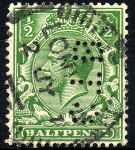
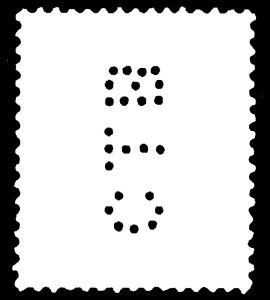 |
| My Reference |
CTB-2 |
| Perfin Soc. Ref. |
C7540.01 |
| Perfin User |
Commercial Telegram Bureau.
(was also a publishing company) |
| Precancel Types: |
A7 code F |
| Date range: |
1899 to c1922 |
|
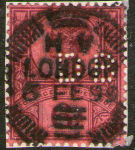
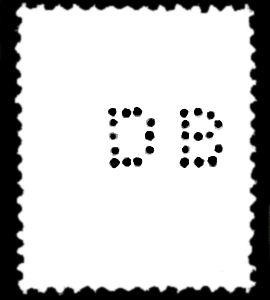 |
| My Reference |
DB-1 |
| Perfin Soc. Ref. |
D0210.02v |
| Perfin User |
Deutsche Bank (Berlin), 4 George Yard,
Lombard St, London EC. |
| Precancel Types: |
A9 code HV (Holborn Viaduct) |
| Date range: |
4/8/85 to 13/7/99 |
|
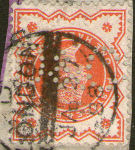
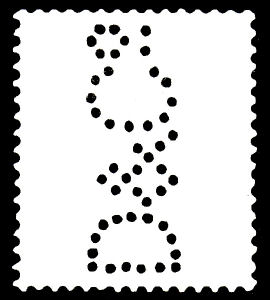 |
| My Reference |
DC-1 |
| Perfin Soc. Ref. |
D0850.01M |
| Perfin User |
Davis & Co, 1 Finch Lane, Cornhill, London EC.
Later at 95 Bishopsgate, London EC2 |
| Precancel Types: |
Bar codes A, B and 4f code 6 (C9). |
| Date range: |
3/6/1884 to Dec.1956 |
|
 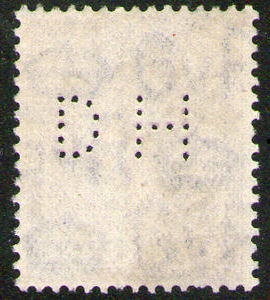 |
| My Reference |
DH-1 |
| Perfin Soc. Ref. |
D2210.02M |
| Perfin User |
The Daily Herald, 12-16 Wilson St.
Long Acre, London WC2. |
| Precancel Types: |
C8 code 32 and 34 |
| Date range: |
21/10/32 to Feb. 1941 |
|
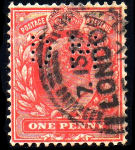
 |
| My Reference |
DM-1 |
| Perfin Soc. Ref. |
D3110.02 |
| Perfin User |
Daily Mail
Carmelite House, London EC. |
| Precancel Types: |
2c code II (A9, 13/2/02) and C8 code ? |
| Date range: |
13/2/1902 to 24/12/1910 |
|
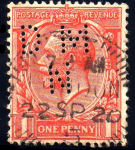
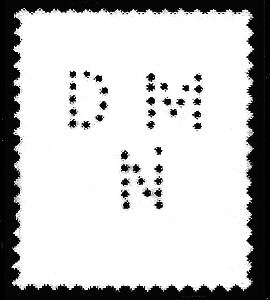 |
| My Reference |
DMN-1 |
| Perfin Soc. Ref. |
D3280.01 |
| Perfin User |
Unknown. |
| Precancel Types: |
C9 code 5 |
| Date range: |
18/9/1920 to 29/12/1920 |
|
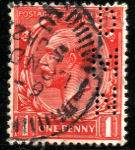
 |
| My Reference |
DMN-2 |
| Perfin Soc. Ref. |
D3290.02 |
| Perfin User |
Probably : Daily Mirror Newspapers Ltd.
London, EC4. |
| Precancel Types: |
C9 code 5 |
| Date range: |
12 July 1924 |
|
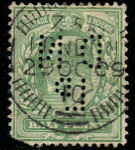
 |
| My Reference |
DN-1 |
| Perfin Soc. Ref. |
D3480.01M |
| Perfin User |
Unknown. |
| Precancel Types: |
C8 code 10 |
| Date range: |
July 1909 to 14 Oct 1911 |
|
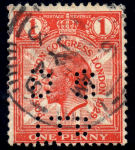
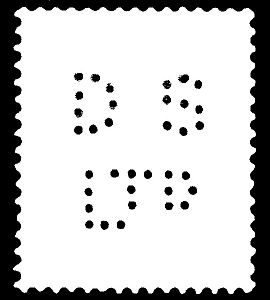 |
| My Reference |
DS-1 |
| Perfin Soc. Ref. |
D4540.01M |
| Perfin User |
Daily Sketch Ltd,
London WC. |
| Precancel Types: |
C8 code 3 |
| Date range: |
Feb. 1929 to 21/7/1948 |
|
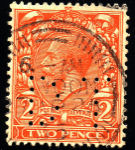
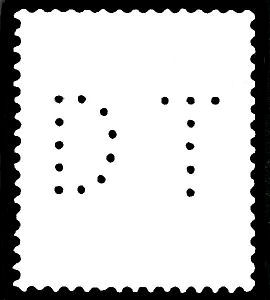 |
| My Reference |
DT-1 |
| Perfin Soc. Ref. |
D4710.03M |
| Perfin User |
Probably : Daily Telegraph, Fleet Street,
London EC. |
| Precancel Types: |
C8 code 35, 37. C9 code 7 |
| Date range: |
10/1/1905 to 26/1/1936 |
|
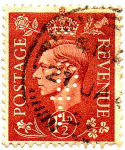
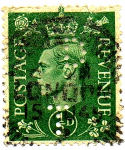
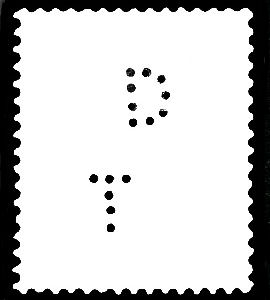 |
| My Reference |
DT-2 (letter-spacing variable) |
| Perfin Soc. Ref. |
D4720.01p (provisional) |
| Perfin User |
Probably : Daily Telegraph,
Fleet Street, London EC. |
| Precancel Types: |
C8 code 2, 37(?) |
| Date range: |
4/4/1942 to 24/9/1947 |
|
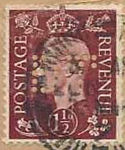
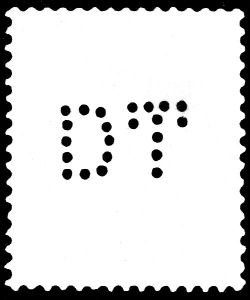 |
| My Reference |
DT-3 |
| Perfin Soc. Ref. |
D4710.02AM |
| Perfin User |
Daily Telegraph, Fleet Street,
London EC. |
| Precancel Types: |
C9 (4f) code 7 |
| Date range: |
Nov 1936 to May 1940 |
|
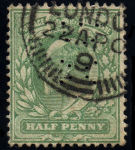
 |
| My Reference |
DX-1 (This often has missing pins) |
| Perfin Soc. Ref. |
D5355.01 |
| Perfin User |
The Daily Express, St Bride St, London EC |
| Precancel Types: |
C8 codes 9, 13 |
| Date range: |
May 1902 to 13/4/1920 |
|
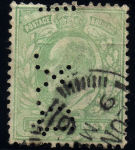 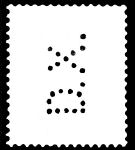 |
| My Reference |
DX-2 (This has larger holes and the extra dot) |
| Perfin Soc. Ref. |
D5360.01 |
| Perfin User |
The Daily Express, St Bride St, London EC |
| Precancel Types: |
C9 code 6 |
| Date range: |
Nov. 1908 to 9/12/1913 |
|
  |
| My Reference |
E-1 (about 5.2mm wide) |
| Perfin Soc. Ref. |
E0010.10, though compare with E0010.09 (6mm) |
| Perfin User |
E0010.09 is W.H. Everett & Son Ltd, Bride St.,
London E.C. but E0010.10 is unknown. |
| Precancel Types: |
C8/4e code 30 |
| Date range: |
1904 - 1940 |
|
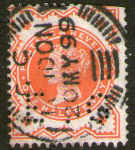
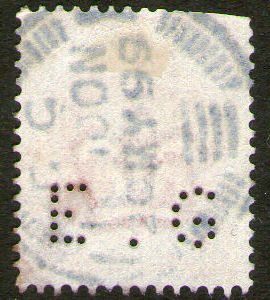 |
| My Reference |
EG-1 |
| Perfin Soc. Ref. |
E1720.01 |
| Perfin User |
The Estates Gazette Ltd, 200 Fleet Street,
London EC |
| Precancel Types: |
A9 code GG, B7 (3d) code H, C8 code 24 |
| Date range: |
20/5/1899 to 19/3/1920 |
|
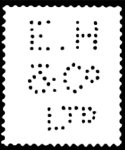 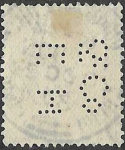
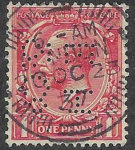 |
| My Reference |
EH-1 |
| Perfin Soc. Ref. |
E1970.01M |
| Perfin User |
E. Hulton & Co Ltd, Printers,
Withy Grove, Manchester |
| Precancel Types: |
C8 code 37 |
| Date range: |
1895 - 1930 |
|
This was intended to be vertical, but was sometimes sideways. The hole between E & H disappeared on one of the multihead
dies around July 1905. E. Hulton & Co also operated in London. |
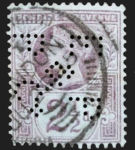
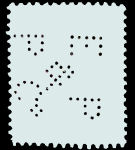 |
| My Reference |
EP-1 |
| Perfin Soc. Ref. |
E3580.01 |
| Perfin Users |
"The Electrician"
Printing & Publishing Co Ltd, Fleet St, London |
| Precancel Types: |
2c (A9) code ii |
| Date range: |
1891 to 1907 |
|
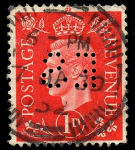
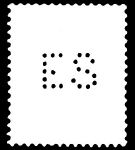 |
| My Reference |
ES-1 |
| Perfin Soc. Ref. |
E4110.03M |
| Perfin Users |
Evening Standard Co Ltd and also
London Express News & Feature Services.
Both Shoe Lane, London EC4 and both
part of Beaverbrook Newspapers Ltd. |
| Precancel Types: |
4b (C8) code 32 |
| Date range: |
1920 to 1970 |
|

 |
| My Reference |
ESC-1 |
| Perfin Soc. Ref. |
E4290.01 |
| Perfin Users |
Unknown |
| Precancel Types: |
B7 (3a or 3d) code ? |
| Date range: |
1928 to 1939 |
|
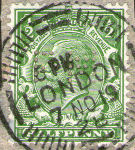
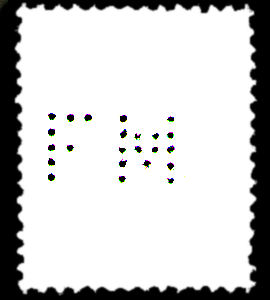 |
| My Reference |
FM-1 |
| Perfin Soc. Ref. |
F2610.01b |
| Perfin User |
Unknown |
| Precancel Types: |
C8 codes 27, 28 |
| Date range: |
11/7/1919 to 7/11/1919 |
|
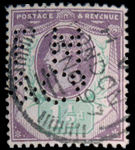
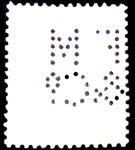 |
| My Reference |
FM-2 |
| Perfin Soc. Ref. |
F2730.01 |
| Perfin Users |
Unknown |
| Precancel Types: |
2c (A9) code HV |
| Date range: |
1895-1905 |
|
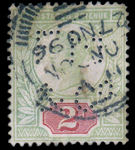 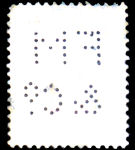 |
| My Reference |
FM-3 |
| Perfin Soc. Ref. |
F2730.03 |
| Perfin Users |
Unknown |
| Precancel Types: |
2c (A9) code HV |
| Date range: |
1895-1900 |
|
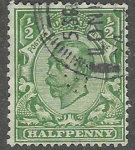
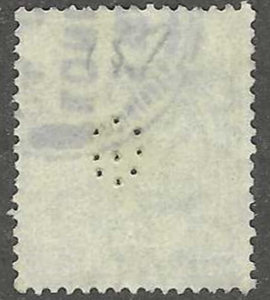 |
| My Reference |
G-1 |
| Perfin Soc. Ref. |
G0009.02v |
| Perfin User |
R.W.Greeff & Co, Thames House, London EC or
Grindlay & Co, Bankers, Agents, London SW1. |
| Precancel Types: |
Probably 4a (C9) code ? |
| Date range: |
1906 - 1930 |
|
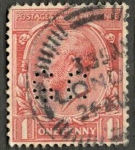
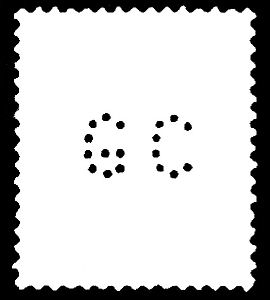 |
| My Reference |
GC-1 |
| Perfin Soc. Ref. |
G0760.02 |
| Perfin User |
The Gardeners Chronicle Ltd,
33 John Street, London WC1. |
| Precancel Types: |
C8 code ? |
| Date range: |
29/1/1912 to 2/10/1940 |
|
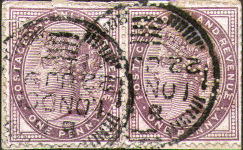
 |
| My Reference |
Graphic |
| Perfin Soc. Ref. |
G4210.01M |
| Perfin User |
The Daily Graphic, Milford Lane,
Strand, London WC |
| Precancel Types: |
A9 code bB |
| Date range: |
Sept. 1888 to 3/7/1901 |
|
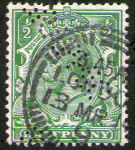
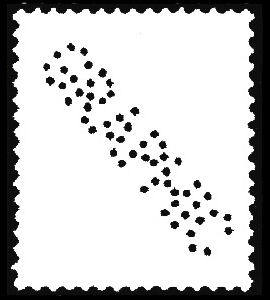 |
| My Reference |
Graphic-2 (taller, different 'A') |
| Perfin Soc. Ref. |
G4210.02M |
| Perfin User |
The Daily Graphic, Tallis House,
Whitefriars, London EC4
Also published 'The Bystander'. |
| Precancel Types: |
C8 code 9 |
| Date range: |
28/9/1903 to 26/1/1935 |
|
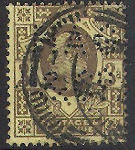
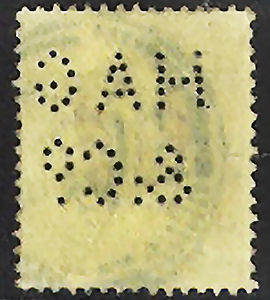 |
| My Reference |
HAG-1 |
| Perfin Soc. Ref. |
H0210.01 |
| Perfin User |
H. Alabaster, Gatehouse & Co,
Consulting Electrical Engineers,
4 Ludgate Hill and 22 Paternoster Row, London EC. |
| Precancel Types: |
C8 (4b) code 9 |
| Date range: |
1895 - 1915 |
|
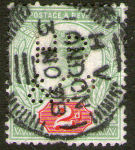
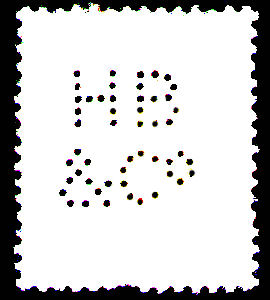 |
| My Reference |
HB-1 |
| Perfin Soc. Ref. |
H0530.01 |
| Perfin User |
Houlder Bros. & Co Ltd.
Shipowners, 146 Leadenhall St. London EC |
| Precancel Types: |
A9 code HV (Holborn Viaduct) |
| Date range: |
11/11/1882 to Sept.1911 |
|
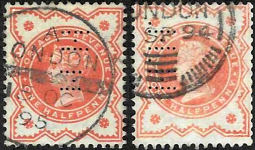
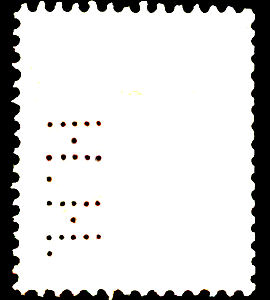 |
| My Reference |
HH-1 |
| Perfin Soc. Ref. |
H3130.01 |
| Perfin User |
Unknown |
| Precancel Types: |
1a(code A) and 2a(code ?) |
| Date range: |
September 1894 to 1905 |
|
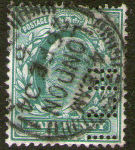
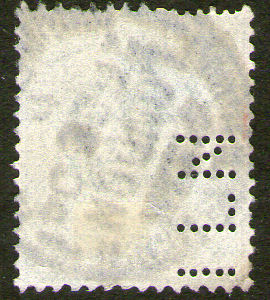 |
| My Reference |
ILN-1 |
| Perfin Soc. Ref. |
I1580.01 |
| Perfin User |
The Illustrated London News & Sketch,
Milford Lane, Strand, London |
| Precancel Types: |
C9 codes 3, 6 |
| Date range: |
29/12/1899 to 26/2/1904 |
|

 |
| My Reference |
INC-1 |
| Perfin Soc. Ref. |
I1780.02 |
Suspected
Perfin User |
Illustrated Newspaper Corp. Ltd.
1 Arundel St. Strand, London WC.
Published 'The Gentleman'. |
| Precancel Types: |
4a / C9 (code 3?) |
| Date range: |
1895 to 1900 |
|
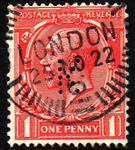
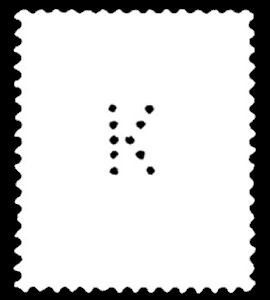 |
| My Reference |
K-2 |
| Perfin Soc. Ref. |
K0010.05 |
Multiple
Perfin Users
in London |
Henry S. King & Co. EC, SW & E2
Kleinwort Sons & Co. 20 Fenchurch St, EC3
Kodak Ltd. 41&43 Clerkenwell Rd.EC
Lloyd Bank Ltd (King's Branch, Pall Mall, SW1) |
| Precancel Types: |
C9(4f) code 6 |
| Date range: |
1902 to 1923 |
|
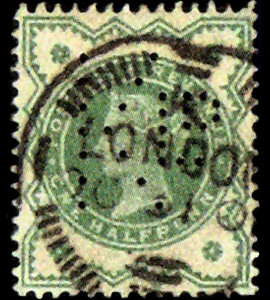
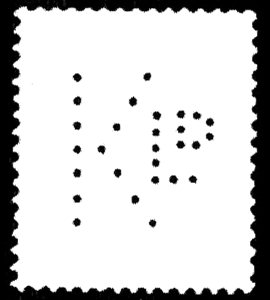 |
| My Reference |
KLD-1 |
| Perfin Soc. Ref. |
K1260.03 |
| Perfin User |
Kodak Limited, London. |
| Precancel Types: |
A9(2a) code K |
| Date range: |
1895 - 1939 |
|
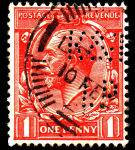
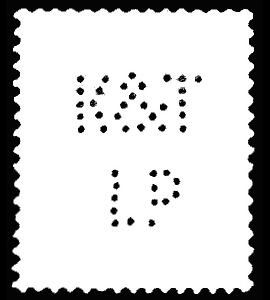 |
| My Reference |
KT-1 |
| Perfin Soc. Ref. |
K1710.01 |
| Perfin User |
Kearley & Tonge Ltd.
Wholesale Grocers,Provision Merchants,
Tea Blenders,
Mitre Sq. London EC3 |
| Precancel Types: |
C8 code 24 |
| Date range: |
10/11/1925 to 19/7/1937 |
|
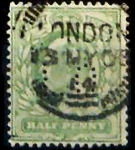
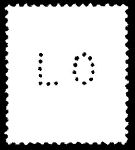 |
| My Reference |
LO-1 |
| Perfin Soc. Ref. |
L4260.02 |
| Perfin User |
London Opinion,
Chandos Street,
Strand, London. |
| Precancel Types: |
C9 (4a) code 14 |
| Date range: |
1908 - 1918 |
|
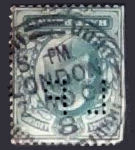
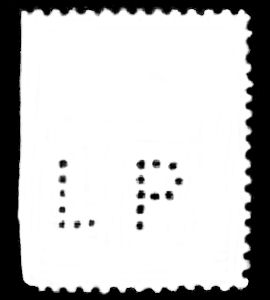 |
| My Reference |
LP-5 |
| Perfin Soc. Ref. |
L4360.07 |
| Perfin User |
Lady's Pictorial,
172 Strand, London WC. |
| Precancel Types: |
C8 (4b) code 8 |
| Date range: |
? |
|

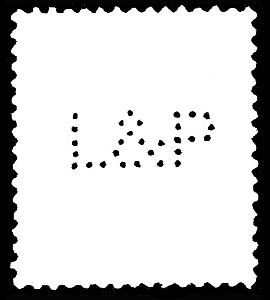 |
| My Reference |
LP-1a (rounded '&') |
| Perfin Soc. Ref. |
L4380.01a |
| Perfin User |
London & Paris Exchange Ltd,
Bankers, London EC2 |
| Precancel Types: |
? |
| Date range: |
16/5/1895 to 3/11/1936 |
|

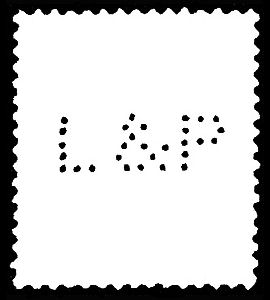 |
| My Reference |
LP-1ab (wide gap between 'L' and 'E') |
| Perfin Soc. Ref. |
L4380.01b |
| Perfin User |
|
| Precancel Types: |
? |
| Date range: |
1906 |
|

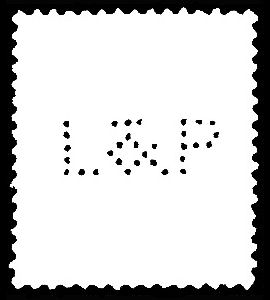 |
| My Reference |
LP-2A (straight '&' top) |
| Perfin Soc. Ref. |
L4380.02A |
| Perfin User |
|
| Precancel Types: |
? |
| Date range: |
21/3/1906 to 12/12/1911 |
|
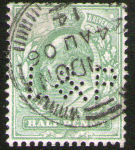
 |
| My Reference |
LP-3M (angular '&' wide top loop) |
| Perfin Soc. Ref. |
L4380.03M |
| Perfin User |
London & Paris Exchange Ltd,
Moorgate Street, London EC3 |
| Precancel Types: |
C8 code 11, 12; C9 code 14 |
| Date range: |
1902 to 25/1/1911 |
|
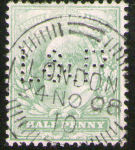
 |
| My Reference |
LP-3a |
| Perfin Soc. Ref. |
L4380.03a |
| Perfin User |
London & Paris Exchange Ltd,
Moorgate Street, London EC3 |
| Precancel Types: |
C8 codes 10, 11, 12, 15, 20; C9 code 14 |
| Date range: |
25/4/1906 to 24/11/1908 |
|
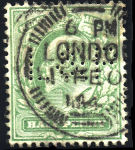
 |
| My Reference |
LP-3b (small top loop in '&') |
| Perfin Soc. Ref. |
L4380.03b |
| Perfin User |
Probably : London & Paris Exchange Ltd,
Moorgate Street, London EC3 |
| Precancel Types: |
C8 codes 10, 11, 12, 15, 20; C9 code 14 |
| Date range: |
6/2/1897 to 10/11/1908 |
|
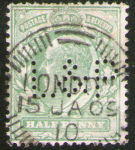  |
| My Reference |
LP-4a (tall top loop in '&') |
| Perfin Soc. Ref. |
L4380.04a |
| Perfin User |
London & Paris Exchange Ltd,
Moorgate Street, London EC3 |
| Precancel Types: |
C8 code 10 |
| Date range: |
31/12/1908 to 15/1/1909 |
|
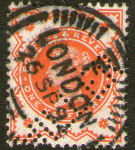
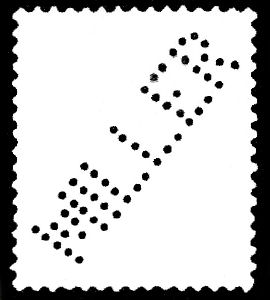 |
| My Reference |
Miller |
| Perfin Soc. Ref. |
M3130.01 |
| Perfin User |
'The Miller', 24 Mark Lane, London EC
(a weekly journal published Monday evenings) |
| Precancel Types: |
A7 codes F, f |
| Date range: |
12/7/1896 to 8/5/1905 |
|
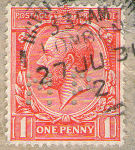
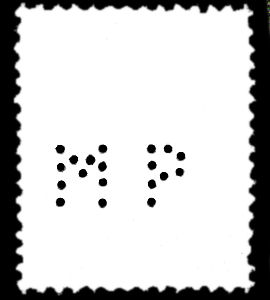 |
| My Reference |
MP-1 |
| Perfin Soc. Ref. |
M4410.01M |
| Perfin User |
Probably :
The Morning Post, Strand, London WC |
| Precancel Types: |
C8 codes 2, 9 |
| Date range: |
21/3/1927 to 30/7/1937 |
|
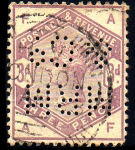
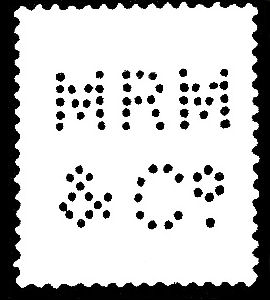 |
| My Reference |
MRM-1 |
| Perfin Soc. Ref. |
M4800.01M |
| Perfin User |
M R Meyer & Co, Merchants,
Mincing Lane, London EC |
| Precancel Types: |
A9 code HV (Holborn Viaduct) |
| Date range: |
31/3/1886 to 21/5/1897 |
|
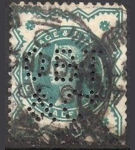
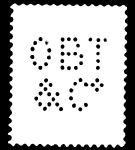 |
| My Reference |
OBT-1 |
| Perfin Soc. Ref. |
O270.01 |
| Perfin User |
O'Brien, Thomas & Co,
Wholesale Ironmongers,
White Lion & St Paul's Wharves,
17/18 Upper Thames St, London EC3. |
| Precancel Types: |
A9 (2a) code C |
| Date range: |
7 May 1895 - 9 July 1920 |
|
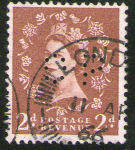
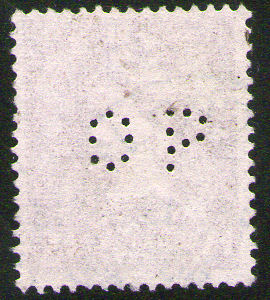 |
| My Reference |
OP-1 |
| Perfin Soc. Ref. |
O1510.01M |
| Perfin User |
Odhams Press Ltd.,
93 Long Acre, London WC2. |
| Precancel Types: |
D8 code 34 |
| Date range: |
3/7/1942 to 2/11/1970 |
|

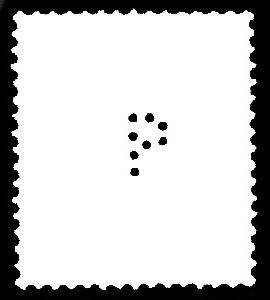 |
| My Reference |
P-1 |
| Perfin Soc. Ref. |
P0008.02M |
| Perfin User |
Probably : "The People" newspaper published by
Oldham Press Ltd.92-93 Long Acre, and
222 Strand, London WC2. |
| Precancel Types: |
C6 codes ?; C8 code 9 |
| Date range: |
1941 to 1986 |
|

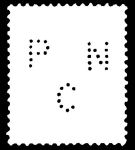 |
| My Reference |
PNC-1 |
| Perfin Soc. Ref. |
P3360.01 |
| Perfin User |
Pictorial Newspapers Co (1910),
Ltd, 23 Bouverie St. London EC4.
{Voluntary liquidation 25/6/1920. Became
part of Daily Mirror Newspapers Ltd.} |
| Precancel Types: |
C9b (4d) code 5 |
| Date range: |
circa 1920 |
|
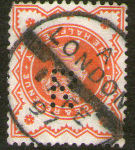
 |
| My Reference |
R-1 |
| Perfin Soc. Ref. |
R0012.03 |
| Perfin User |
T. Rastall & Son, Booksellers, Stationers etc.
Eccleston Street, London SW. |
| Precancel Types: |
Bar code A (also WHS Type-V) |
| Date range: |
6/1/1892 to 7/3/1911 |
|
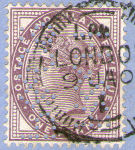
 |
| My Reference |
RHP-1 |
| Perfin Soc. Ref. |
R2480.01 |
| Perfin User |
Probably : Robert & Henry Parnall & Co
Wholesale Clothiers & Woollen Warehousemen,
7-10 Fell St. and 71 Wood St. London EC |
| Precancel Types: |
C9 code 1 |
| Date range: |
20/7/1893 to 30/12/1902 |
|
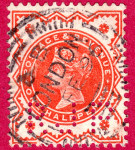
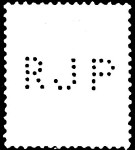 |
| My Reference |
RJP-1 |
| Perfin Soc. Ref. |
R3030.01M |
| Perfin User |
Unknown at this time |
| Precancel Types: |
A9 / 2c code bB |
| Date range: |
1890 to 1905 |
|
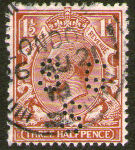
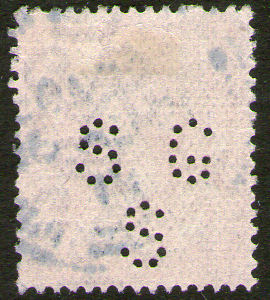 |
| My Reference |
SGS-1 |
| Perfin Soc. Ref. |
S3250.01 |
| Perfin User |
Scott, Greenwood & Son Ltd.
Publishers {e.g. The Pottery Gazette},
8 Broadway, Ludgate Hill, London EC4 |
| Precancel Types: |
C8 code 19 |
| Date range: |
13/3/1905 to 23/4/1938 |
|
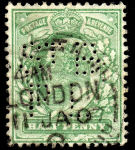
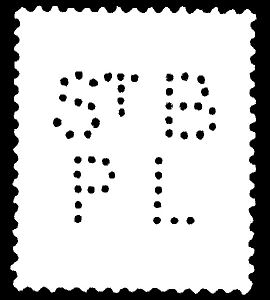 |
| My Reference |
STB-1 |
| Perfin Soc. Ref. |
S7180.01 |
| Perfin User |
Probably : St Brides Press Ltd,
24 Bride Lane, Fleet St. London EC. |
| Precancel Types: |
C8 code 8 |
| Date range: |
10/4/1902 to 18/6/1920 |
|
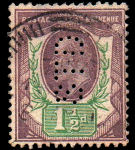
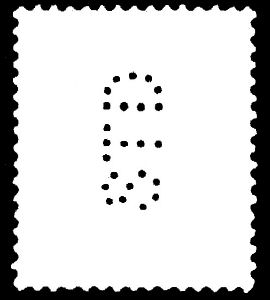 |
| My Reference |
STD-1 |
| Perfin Soc. Ref. |
S7320.01 |
| Perfin User |
"The Standard" Newspaper,
104 Shoe Lane. London EC. |
| Precancel Types: |
? |
| Date range: |
1910 - 1914 |
|
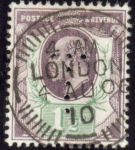
 |
| My Reference |
T-1 |
| Perfin Soc. Ref. |
T0007.04 |
| Perfin User |
The Tribune Rendezvous,
London |
| Precancel Types: |
C8 code 10 |
| Date range: |
9/3/1906 to 20/9/1928 |
|
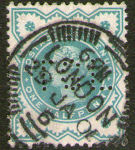
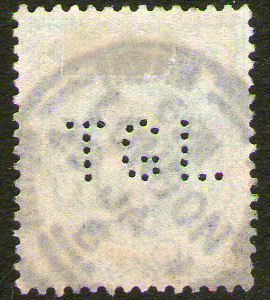 |
| My Reference |
TGL-1 |
| Perfin Soc. Ref. |
T1940.02 |
| Perfin User |
The Gentlewoman Ltd,
1 Arundel St, Strand, London WC |
| Precancel Types: |
C9 code 4, 5, 6 |
| Date range: |
30/10/1900 to 26/11/1907 |
|
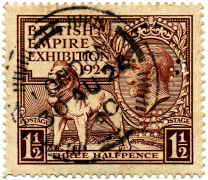
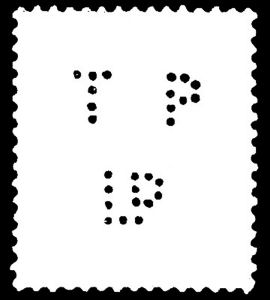 |
| My Reference |
TPL-1 (Small LD) |
| Perfin Soc. Ref. |
T3600.01 |
| Perfin User |
Temple Press Ltd,
Publishers & Printers,
5-7 Rosebery Avenue, London EC. |
| Precancel Types: |
4b(C8) code 20 |
| Date range: |
27 May 1924 - 27 Sept. 1927 |
|
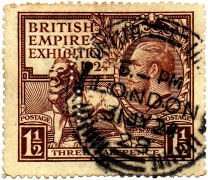 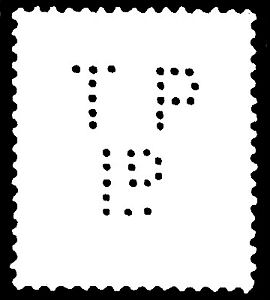 |
| My Reference |
TPL-2 (Large LD) |
| Perfin Soc. Ref. |
T3600.02a |
| Perfin User |
Temple Press Ltd,
Printers,
7-15 Rosebery Avenue, London EC. |
| Precancel Types: |
4e(C8) code 28 |
| Date range: |
12 June 1912 - 31 July 1923 |
|
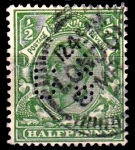 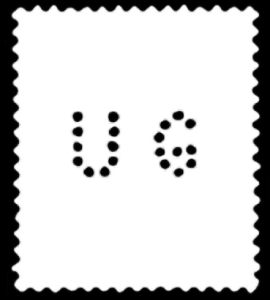 |
| My Reference |
UG-1 |
| Perfin Soc. Ref. |
T0860.01M |
| Perfin User |
Upcott Gill & Son Ltd., Printers
& Publishers,
54 Drury Lane,
and 170 Strand, London WC. |
| Precancel Types: |
4b(C8) code 2 or 3 ? |
| Date range: |
1895 - 1915 |
|
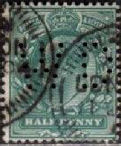 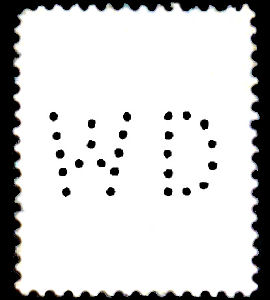 |
| My Reference |
WD-1 |
| Perfin Soc. Ref. |
W1860.09 |
| Perfin User |
Wetherall Drake & Co Ltd,
St Andrews, Guernsey, & London. |
| Precancel Types: |
4b(C8) code 9 ? |
| Date range: |
? |
|

 |
| My Reference |
WDC-1 |
| Perfin Soc. Ref. |
W1970.01 |
| Perfin User |
William Dunn & Co. Ltd.,
Broad Street Ave., London EC2 |
| Precancel Types: |
2c(A9) code Aa |
| Date range: |
2/7/1885 to 4/1/1907 |
|
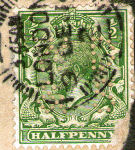
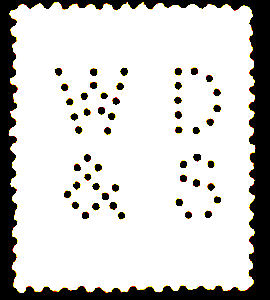 |
| My Reference |
WDS-1 |
| Perfin Soc. Ref. |
W2040.03 |
| Perfin User |
William Dawson & Sons Ltd,
Pilgrim St, London EC |
| Precancel Types: |
C9 code 2 |
| Date range: |
9/12/1914 |
|

 |
| My Reference |
WDS-2 (different 'W') |
| Perfin Soc. Ref. |
W2040.06 |
| Perfin User |
William Dawson & Sons Ltd,
Pilgrim St, London EC |
| Precancel Types: |
? - on cover with W2040.03M |
| Date range: |
c1925 |
|
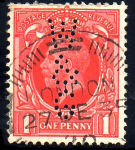
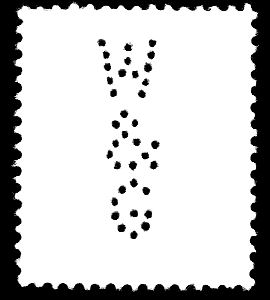 |
| My Reference |
WHS-2 |
| Perfin Soc. Ref. |
W2950.01 |
| Perfin User |
Waring & Gillow Ltd,
House Furnishers,
164-182 Oxford St, London W1. |
| Precancel Types: |
C8 code 20 |
| Date range: |
27/12/1935 |
|
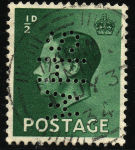
 |
| My Reference |
WHS-1 |
| Perfin Soc. Ref. |
W3800.03M |
| Perfin User |
W H Smith & Sons Ltd,
Strand, London WC2 |
| Precancel Types: |
C8 code 34 |
| Date range: |
1/7/37 |
|

 |
| My Reference |
WHS-2 |
| Perfin Soc. Ref. |
W3800.01M |
| Perfin User |
W H Smith & Sons Ltd,
Strand, London WC2 |
| Precancel Types: |
C8 code 33, D8 code 10 |
| Date range: |
8/6/1956 to 29/3/1960 |
|
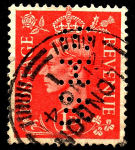
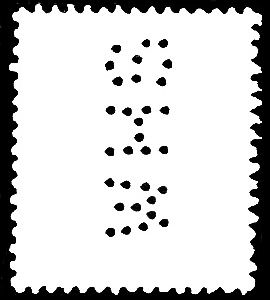 |
| My Reference |
WHS-3 wider (16.5mm, broad 'S') |
| Perfin Soc. Ref. |
W3800.01b |
| Perfin User |
Probably : W H Smith & Sons Ltd,
Strand, London WC2 |
| Precancel Types: |
C8 code 1 (none) |
| Date range: |
1939-1945 |
|
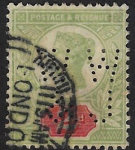
 |
| My Reference |
WWJ-1 |
| Perfin Soc. Ref. |
W8090.01 |
| Perfin User |
W Wingate & Johnston (Shipping Agents)
17-18 Aldersgate Street, London EC. |
| Precancel Types: |
? could be 4a, 4c or 4d (C9,C9a,C9b) |
| Date range: |
1895 - 1910 |
|
This last, WW&J, E.H & Co., G-1, H.H. and INC-1 are all courtesy of Dan Baugher.
This pdf download also lists:
BGL, BTJ, ET, HAG/&Co, K and S&S.
I have added a 'framework' below in the hope that examples can be added.

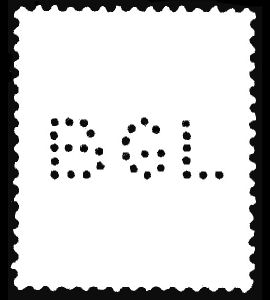 |
| My Reference |
BGL-1 |
| Perfin Soc. Ref. |
B3070.01M |
| Perfin User |
B G Lennon & Co. Ltd,
12/14 Lafone St. Tower Bridge, London SE1
53-58 Queen Elizabeth St, Horseley Down,
London SE. and 14 Bunhill Row, London EC. |
| Precancel Types: |
? |
| Date range: |
2/2/1895 to 24/3/1937 |
|

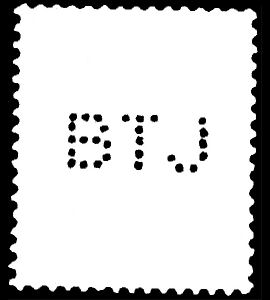 |
| My Reference |
BTJ-1 |
| Perfin Soc. Ref. |
B7210.01 |
| Perfin User |
The British Trade Journal, 24 Mark Lane,
London EC. |
| Precancel Types: |
? |
| Date range: |
19/11/1894 to 6/9/1911 |
|

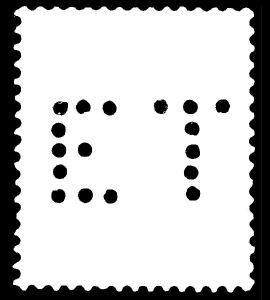 |
| My Reference |
ET-1 |
| Perfin Soc. Ref. |
E4660.03 |
| Perfin User |
The Electrical Times, Technical Publishers,
8 Bream's Buildings, Chancery Lane,
and Sardinia St, Kingsway, London EC. |
| Precancel Types: |
? |
| Date range: |
17/3/1905 to May 1938 |
|

 |
| My Reference |
K-1 |
| Perfin Soc. Ref. |
K0010.14 |
| Perfin User |
Probably : Kemsley Newspapers Ltd,
London EC. |
| Precancel Types: |
? |
| Date range: |
15/9/1937 |
|

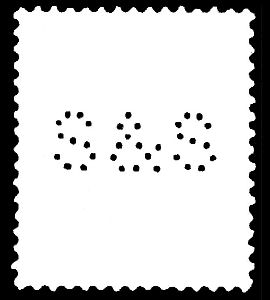 |
| My Reference |
SS-1 |
| Perfin Soc. Ref. |
S6440.03 |
| Perfin User |
Unknown |
| Precancel Types: |
? |
| Date range: |
Jan.1892 to 27/2/1905 |
|
Below are some important relevant examples:
The 'Bar Type' (Chandler type 1a, thought to have been used on papers posted after midnight) has two date formats.
Chandler describes for his type 2C with code 'i i'.
Code 'A' seems to start with reversed (month, day, year) and switch to normal (day, month, year) somewhere between April and August 1894.
Code 'B' seems to be reversed (month, day, year) all the way from 1878 to 1904.
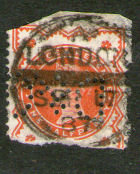 |
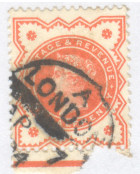 |
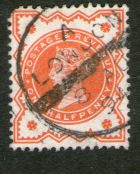 |
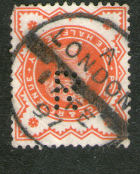 |
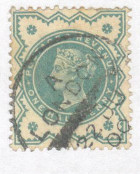 |
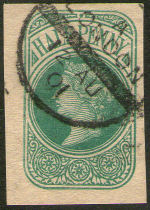 |
| SP 17 87 |
AP 7 94 |
8 AU 94 |
17 FE 97 |
22 JU 00 |
12 AU 01 |
Type 'Bar'(1a) code A, reversed date.
|
Bar Type 1a code A |
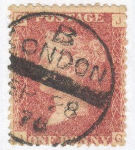 |
 |
 |
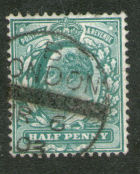 |
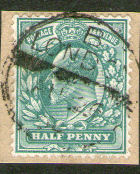 |
| SP 28 78 (plate 207) |
JA 27 88. |
JU 19 97. |
MR 06 03. |
AU 26 04. |
| Type 'Bar'(1a) code B with reversed date from 1878 to 1904. |
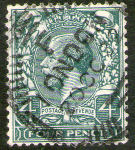 |
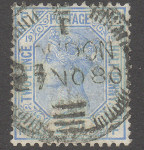 |
Type A7(2e) code 'F' dated 20 OC 22,
Chandler says used until 1921 |
Type A9a(2b) code f dated 27 NO 80
(Earlier than 'From' date given above). |
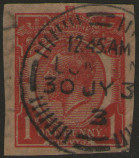 |
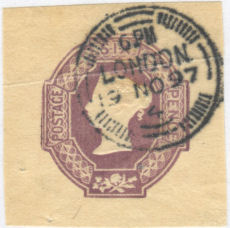 |
 |
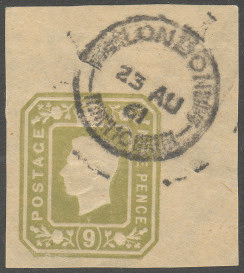 |
Type C8(4b) code 3
(Unrecorded by Chandler). |
Type C9(4a) with 'Clear' date. |
Type C9(4a)-Reversed code 3
dated MY 10 00 |
Type D8(5a) code 10 on 9d KGVI dated 23 AU 1961
(Last year of use for 9d KGVI, Also see note 15 above). |
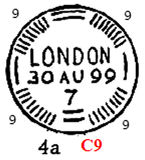
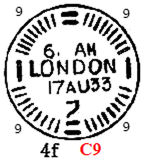
On the face of it, you would think that these two are readily distinguishable.
But for one thing, it is unusual to be able to see all of the cancel.
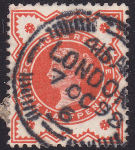 |
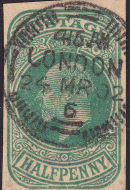 |
 |
 |
 |
 |
C9(4a) code 6
of October 1898 |
C9(4a) code 6
of March 1902 |
C9(4a) code 6
of July 1904 |
C9(4a) code 6
of August 1909 |
C9(4a) code 6
of November 1922 |
C9(4f) code 7
on a 1937 stamp |
The first 4 all have 'time in the clear' of early in the morning, whereas the illustration of 4a has no time.
Despite all being code 6, they are not all the same, the code number '6' gradually gets bigger, the time gains a dot after the hour.
It is likely that more than one copy of each hand-stamp existed, but it is also likely that they sometimes needed replacing.
According to Chandler, Type 4a was in use from 1896 to 1915 and Type 4f was in use from 1924 to 1933, though I have seen a poor one
with code 7 on a stamp that wasn't issued until 1937. Only Types 4a and 4f are listed as having a code 6 or 7.
I think the last 2 examples must also be Type 4f. These are the only examples of Type 4f that I have seen, they are quite scarce.
Chandler only lists 4f as having time only 'Clear', but then he listed 4a as being 'Clear' and illustrated it with a 'None'.
The pertinent difference between 4a and 4f would seem to be that 'LONDON' is below the top bars on 4f and the bottom bars are taller and more widely spaced.
I will change the date range of Type 4f from 1924-1933 to now be 1922-1937 and change it to 'Clear or none'.

 |
Type A9(2a) code 'K', another new one to add to Chandlers' list !!!
(2 examples acquired a day apart !) |


|
Type A9b (10, 10, 9, 9) code F.
The original scheme of J. H. Chandler does not have such a type.
I added them as Type 2g. |
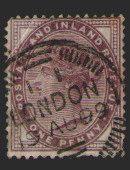 | 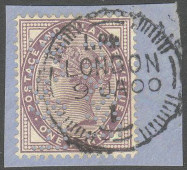 |
| Type A9(2c) code I I, dated 19 AU 99 |
Type C9(4a) code 1 dated 9 JA 00
Perfinned R&H / P&Co |
| The only precancels I have on this common stamp ! |
Dates seen:
| Milled Edge Precancels I have ('emb.' = 'embossed') |
| Date |
Denomination |
Type |
Code |
| 'SP 17 87' |
½d Orange |
Bar(1a)R |
A |
| 'AP 7 94' |
½d Orange |
Bar(1a)R |
A |
| '8 AU 94' |
½d Orange |
Bar(1a) |
A |
| '17 FE 97' |
½d Orange |
Bar(1a) |
A |
| '22 JU 00' |
½d Green |
Bar(1a) |
A |
| '12 AU 01' |
½d stationery |
Bar(1a) |
A |
| 'SP 28 78' |
1d Red pl.207 |
Bar(1a)R |
B |
| 'JA 27 88' |
½d Orange |
Bar(1a)R |
B |
| 'JU 19 97' |
½d stationery |
Bar(1a)R |
B |
| 'MR 6 03' |
½d Green |
Bar(1a)R |
B |
| 'AU 26 04' |
½d Green |
Bar(1a)R |
B |
| '24 JY 76' |
1d plate 156 |
A9(2a) |
C |
| '13 FE 95' |
½d stationery |
A9(2a) |
C |
| '4 SP 71' |
½d plate 8 |
A9(2a) |
F |
| '6 OC 72' |
1d plate 146 |
A9(2a) |
F |
| '15 AP 73' |
3d plate 10 |
A9(2a) |
F |
| '4 SP 74' |
3d plate 14 |
A9(2a) |
F |
| '4 JA 81' |
½d |
A9(2a) |
F |
| '18 FE 81' |
½d |
A9(2a) |
F |
| '22 NO 7?' |
1d Red pl.157 |
A9(2a) |
H |
| '14 AU 76' |
1d Red pl.146 |
A9(2a) |
K |
| '27 FE 85' |
½d Slate |
A9(2a) |
K |
| '8 FE 76' |
1d plate 171 |
A9(2a) |
f |
| '8 MR 78' |
½d plate 14 |
A9(2a) |
f |
| '6 MY 85' |
½d Stubbs wrapper |
A9(2a) |
h |
| '27 NO 80' |
2½d plate 19 |
A9a(2b) |
f |
| '11 MY 94' |
4d |
A9(2c) |
A a |
| '11 MY 94' |
½d |
A9(2c) |
b B |
| '10 AU 01' |
½d |
A9(2c) |
C C |
| '3 NO 98' |
2d HB&Co perfin |
A9(2c) |
H V |
| '14 SP 88' |
4d |
A9(2c) |
H V |
| '25 FE 96' |
4d |
A9(2c) |
H V |
| '5 FE 99' |
6d DB perfin |
A9(2c) |
H V |
| '9 NO 98' |
½d verm. |
A9(2c) |
I I |
| '11 NO 99' |
½d verm. |
A9(2c) |
I I |
| '4 DE 01' |
½d green |
A9(2c) |
I I |
| '6 SP 01' |
½d wrapper |
A9(2c) |
I I |
| '23 JA 02' |
½d stationery |
A9(2c) |
I I |
| '9 SP 02' |
½d wrapper |
A9(2c) |
I I |
| 'DE 7 94' |
2d + 1½d emb. |
A9(2c)-Rev |
i i |
| 'JU 7 95' |
6d emb |
A9(2c)-Rev |
i i |
| 'OC 25 95' |
2½d + 2½d emb. |
A9(2c)-Rev |
i i |
| 'NO 8 95' |
4d emb |
A9(2c)-Rev |
i i |
| '? SP 96' |
½d |
A9(2d) |
F |
| '8 SP 99' |
1d stationery |
A9(2d) |
F |
| '17 AU 91' |
1½d |
A7(2e) |
f |
| '14 NO 95' |
½d |
A7(2e) |
f |
| '1 DE 97' |
½d stationery |
A7(2e) |
f |
| '14 DE 97' |
½d |
A7(2e) |
f |
| '7 FE 98' |
½d |
A7(2e) |
f |
| '4 JY 98' |
½d |
A7(2e) |
f |
| '14 JY 99' |
2½d |
A7(2e) |
f |
| '13 SP 99' |
½d |
A7(2e) |
f |
| '8 MR 02' |
½d |
A7(2e) |
f |
| FE to JY '05 |
8 x ½d stamps |
A7(2e) |
f |
| 22 NOV 06 |
½d |
A7(2e) |
f |
| 21 AP 11 |
½d |
A7(2e) |
f |
| 17 JU 13 |
½d |
A7(2e) |
f |
| 18 AU 13 |
½d |
A7(2e) |
f |
| 27 AU 13 |
½d |
A7(2e) |
f |
| '14 OC 95' |
½d stationery |
A7(2e) |
F |
| '26 SP 98' |
½d |
A7(2e) |
F |
| '19 JY 99' |
½d |
A7(2e) |
F |
| '25 JY 00' |
½d |
A7(2e) |
F |
| '7 JU 12' |
½d |
A7(2e) |
F |
| '25 JU 12' |
½d |
A7(2e) |
F |
| 1913 |
7 ½d stamps |
A7(2e) |
F |
| '21 AU 13' |
½d emb. |
A7(2e) |
F |
| '20 OC 22' |
4d |
A7(2e) |
F |
| '23 OC 97' |
½d |
A7(2e) |
G |
| 1884-87 |
2d |
A9b |
F |
| '18 SP 85' |
9d |
A9b |
F |
| '27 MR 02' |
½d |
B7(3a) |
A |
| '14 MY 00' |
½d |
B7(3a) |
B |
| '27 FE 01' |
½d Wrapper |
B7(3a) |
B |
| '15 OC 01' |
½d |
B7(3a) |
C |
| '20 MY 02' |
½d |
B7(3a) |
C |
| '2 MY 02' |
½d |
B7(3a) |
E |
| '4 JY 02' |
½d |
B7(3a) |
E |
| '31 JA 02' |
½d |
B7(3a) |
F |
| '20 JU 02' |
½d |
B7(3a) |
F |
| '21 AU 39' |
1d stationery |
B7(3d) |
H |
|
|
| Date |
Denomination |
Type |
Code |
| '9 JA 00' |
1d |
C9(4a) (Clear) |
1 |
| '19 NO 03' |
1d wrapper |
C9(4a) (Clear) |
1 |
| '17 AP 97' |
2s6d |
C9(4a) (Clear) |
1 |
| '2 AU 00' |
½d |
C9(4a) (Clear) |
2 |
| '31 JA 08' |
1d wrapper |
C9(4a) (Clear) |
2 |
| 'MY 10 00' |
1½d |
C9(4a)-Rev |
3 |
| '19 NO 97' |
6d emblems |
C9(4a) (Clear) |
4 |
| '7 SP 00' |
½d |
C9(4a) (None) |
4 |
| '4 JA 05' |
1d wrapper |
C9(4a) (Clear) |
4 |
| '7 FE 99' |
½d |
C9(4a) (Clear) |
5 |
| '4 DE 02' |
2d |
C9(4a) (Clear) |
5 |
| '2 MR 09' |
3d |
C9(4a) (Clear) |
5 |
| '29 DE 99' |
½d perfinned |
C9(4a) (Clear) |
6 |
| '19 JY 01' |
½d |
C9(4a) (Clear) |
6 |
| '16 MY 05' |
½d stationery |
C9(4a) (Clear) |
6 |
| '2 NO 05' |
½d perfinned |
C9(4a) (Clear) |
6 |
| '28 AU 09' |
½d |
C9(4a) (Clear) |
6 |
| '30 DE 10' |
1½d |
C9(4a) (Clear) |
6 |
| '6 NO 97' |
½d |
C9(4a) (Clear) |
7 |
| '13 NO 97' |
½d |
C9(4a) (Clear) |
7 |
| '3 FE 11' |
½d |
C9(4a) (Clear) |
7 |
| '14 FE 13' |
½d |
C9(4a) (None) |
7 |
| '11 AP 14' |
1d |
C9(4a) (Clear) |
14 |
| '10 MY 37' |
½d, 1d, 2½d FDC |
C8(4b) (26 mm) |
2 |
| '30 JY 3?' |
1d stationery |
C8(4b) (26 mm) |
3 |
| '21 MR 04' |
½d wrapper |
C8(4b) (25 mm) |
9 |
| 1913 |
A dozen 1d stamps |
C8(4b) (25.5 mm) |
9 |
| 21 MR 01 |
1½d QV |
C8(4b) (24 mm) |
10 |
| 1905 |
2 ½d stamps |
C8(4b) (24.5 mm) |
10 |
| 1902-10 |
7 1½d stamps |
C8(4b) (24.5 mm) |
10 |
| 2 AU 12 |
1d stamp |
C8(4b) (24 mm) |
10 |
| 7 AU 12 |
1d stamp |
C8(4b) (24 mm) |
10 |
| 28 MY 16 |
3d stamp |
C8(4b) (24.5 mm) |
10 |
| MR 56 |
1½d wrapper |
C8(4b) (24 mm) |
10 |
| 1906-08 |
21 ½d stamps |
C8(4b) (26 mm) |
11 |
| 6 MY 08 |
1d stamp |
C8(4b) (25 mm) |
11 |
| 8 AP 13 |
1d stationery |
C8(4b) (28 mm) |
11 |
| 1906-08 |
16 ½d stamps |
C8(4b) (26 mm) |
12 |
| 19 SP 02 |
½d Eason wrapper |
C8(4b) |
13 |
| 9 MY 05 |
½d Stationery |
C8(4b) |
13 |
| 19 JA 07 |
5d |
C8(4b) |
13 |
| '19 MY 08' |
1d perfinned |
C8(4b) (26 mm) |
15 |
| '4 JY 08' |
½d perfinned |
C8(4b) (26 mm) |
15 |
| '10 NO 08' |
½d perfinned |
C8(4b) (26 mm) |
15 |
| '10 JU 14' |
½d |
C8(4b) (26 mm) |
18 |
| '28 FE 08' |
½d perfinned |
C8(4b) |
20 |
| '11 AP 28' |
½d |
C8(4b) (26 mm) |
20 |
| '23 AP 24' |
½d |
C8(4b) (26 mm) |
31 |
| '8 JU 56' |
½d+1½d wrapper |
C8(4b) (clear) |
33 |
| '19 NO 57' |
2½d wrapper |
C8(4b) ('- A -') |
33 |
| '30 AU 53' |
1½d wrapper |
C8(4b) (25 mm) |
34 |
| '31 MR 21' |
½d |
C8(4b) |
36 |
| '24 JA 14' |
1d |
C8(4b) |
37 |
| '24 FE 21' |
½d |
C8(4b) |
38 |
| '22 JU 48' |
3d wrapper |
C8(4b) (25.5 mm) |
38 |
| '29 DE 03' |
½d |
C9a(4c) |
4 |
| '13 SP 05' |
½d |
C9a(4c) |
4 |
| '1 SP 06' |
1½d |
C9b(4d) |
5 |
| '8 JU 09' |
½d |
C9b(4d) |
5 |
| '18 SP 15' |
2½d |
C8(4e) (Clear) |
27 |
| '21 SP 21' |
3d |
C8(4e) (Clear) |
27 |
| '8 MR 29' |
1½d |
C8(4e) (None) |
29 |
| '31 DE 26' |
½d |
C8(4e) (Clear) |
30 |
| '3 MR 60' |
2½d |
D8(5a) |
10 |
| '24 MR 60' |
6d+2½d emb. |
D8(5a) |
10 |
| '23 AU 61' |
9d emb. |
D8(5a) |
10 |
| '10 MR 60' |
4d wrapper |
D8(5a) |
34 |
| '23 AU 61' |
9d emb. |
D8(5a) |
10 |
| '10 MR 60' |
4d wrapper |
D8(5a) |
34 |
| |
|
|
|
| |
|
|
|
| |
|
|
|
| |
|
|
|
| |
|
|
|
| |
|
|
|
| |
|
|
|
| |
|
|
|
| |
|
|
|
| |
|
|
|
| |
|
|
|
| |
|
|
|
| |
|
|
|
|
.
Other dates given
Curt Fernau quotes 17/4/1969 as the most recent date seen, but unfortunately has since sold his collection so we do not know which type it was.
James Mackay in an article published in 'Stamp Mart' January 1998 says "This style has continued sporadically until the present day in various guises".
To be fair though, this is taken from his book English and Welsh Postmarks Since 1840 published March 1980.
Anyone have any Decimal Elizabethan examples?
Precancel usage of 'Normal' postmarks.
The milled edge postmarks referred to above were intended for use in London.
However there were still many provincial newspapers with similar needs.
According to John H. Chandler & H. Dagnall in the book mentioned above:
"The provincial papers, on the other hand, were chiefly for local readers and there was little need for a provincial post office to
provide special obliterators for precancelling newspapers. Instead, some of the normal newspaper cancellers
were used for this purpose, but with the time omitted.
Other provincial towns have used the normal numbered barred oval killer to precancel newspapers.
The following are known to have been used in this way."
They then give this list:
| # | Town | Publication |
|---|
| 27 | Arundel | "West Sussex Gazette" |
| 59 | Beccles | "Beccles and Bungay Weekly News" ? |
| 176 | Chelmsford | "Essex County Chronicle", "Essex Weekly News" |
| 265 | Dunmow | ? |
| 285 | Exeter |
"Western Times & Gazette" ? |
| 325 |
Guildford |
"Surrey Advertiser" ? |
| 357 |
Hereford |
"Hereford Times" |
| 359 |
Hertford |
"Herts Mercury", "Herts Guardian" |
| 675 |
St. Albans |
"St. Albans Times" ? |
| 723 |
Southampton |
"Hampshire Express" ? |
| 727 |
Spalding |
"Spalding Free Press" |
| 776 |
Taunton |
"Western Gazette" ? |
| 929 |
Yeovil |
"Western Gazette" |
| 025 |
Bletchley Station |
"Bletchley District Gazette" |
| | | |
In addition they list the following squared circle and CDS:
| Town | Publication |
|---|
| Royston | "Royston Crow" |
| | |
They illustrate this with an upright simplex barred oval with 27 for Arundel and point out that (on stationery at least), ink offset
on the back is a sure sign of precancel usage where wrappers have been stacked.
Of course not all examples of these cancellations will be precancels, but they should account for quite a large proportion of
the halfpenny usage of the period.
The intention of providing these illustrations was to show the type used, not actual examples of precancel use,
as that would need more evidence than the stamp alone can give.
It has had a fringe benefit though, in that John Parmenter has kindly pointed out that my illustrations
are of duplex obliterators with 4 bars top and base (Parmenter type 4VOD).
He considers it more likely that the ones used for precancelling would have been single obliterators (i.e. undated) with 3 bars top and base (Parmenter type 3VOS).
I find the Chandler & Dagnall information much less helpful than it could have been.
I am not sure what "normal" was, simplex, duplex ? The reference to normal newspaper cancellers with the time omitted,
suggests that these were indeed duplex with a date. The examples I have collected are mostly duplex suggesting they were "normal".
But what of the normal numbered barred oval killer, is this meant to imply simplex? 3 bar or 4 bar?
Also which offices did what? It seems like reinventing the wheel is the only way to find out.
I will need to look out for wrappers or at least large pieces that show the whole cancel and have an offset on the back.
Perhaps other examples will come to light.
(any help would be appreciated).
Liverpool
The clear offset on the back indicates that this Liverpool cancellation was used as a pre-cancel.
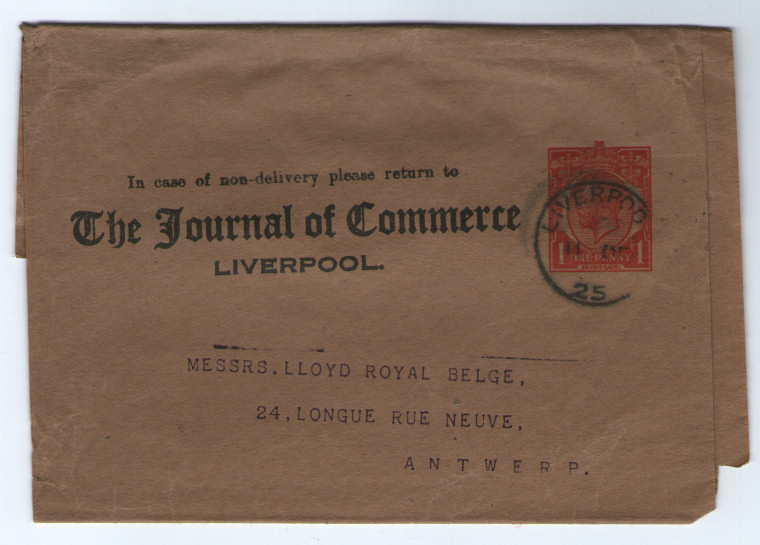
Not exactly 'Local distribution, and Liverpool is big enough to warrant a few milled edge cancellers, but they were only created in London.
This though certainly looks like pre-cancel usage of a 'normal' postmark, an offset is clearly visible, and well after the Victorian era.
Edinburgh NPB
I was alerted to the pre-cancel usage of the Edinburgh NPB cancel by
Michel Letaillieur.
To check this out I bought a cheap batch of 25 wrapper cut-outs with this postmark from eBay
these were in the date range March to November 1896. Only two did not have clear offsets on the back.
I have since added an 1891 example.
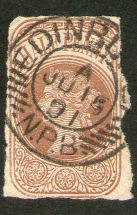
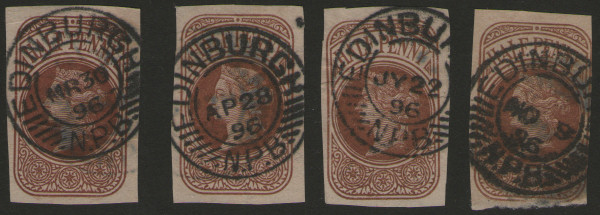
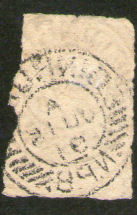

Clearly this was at least sometimes used as a precancel. It is worth looking for offsets on the back of other NPB wrappers.
Here is a 1912 or later example.

This is part of a card promoting Egerton Burnett's royal navy and black serges. The Victorian style cancel is the 860 of Wellington, Somerset.
The distinctive diagonal pattern across the cancel is caused by having a cloth over it, a trick used to reduce the number of times the inkpad is used when having a lot to cancel.
There are also signs of an offset on the back. This all points to an obsolete cancel being used as a pre-cancel.
Image courtesy of Arkadiy Avrorov.
Here is a 1939 example.
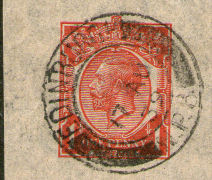
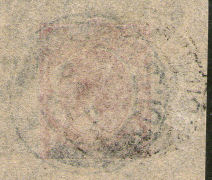
I would be interested to hear of examples proving precancel use by more 'normal' obliterators.
For the same reasons as with the inland 'Public Precancels', the same facilities were needed for Foreign deliveries.
Indeed, considering W. H. Smith already had a Precancel for Foreign mail, it is difficult to understand the reason why so many of their wrappers have 'FB' or 'FB/M' type postmarks.
unless at least some of them were 'Public Precancels'.
Possibly with the institution of the 'Public Precancels' it was considered unnecessary for them to have their own 'SS/F' type precancels and they were withdrawn?

According to J. H. Chandler, GB Journal Volume 17, pp29-32 (1979), the Foreign Branch cancellation shown above was also sometimes used to precancel wrappers.
According to Harry Lane (Gibbons Stamp Monthly July 1999 Pg.49, One die was issued 12.1.72, then a further 24 brass dies were issued 10.12.82 that were subsequently re-cut several times with
20 still in use in 1895. It seems likely that these were for precancel use.
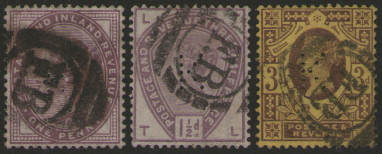
These have a 'K' (for King) perfin
An example on a W. H. Smith & Son wrapper can be seen at StampDomain.com about two thirds of the way down on 1½d yellow and below is a 6d front example.
Both have traces of an offset on the back.
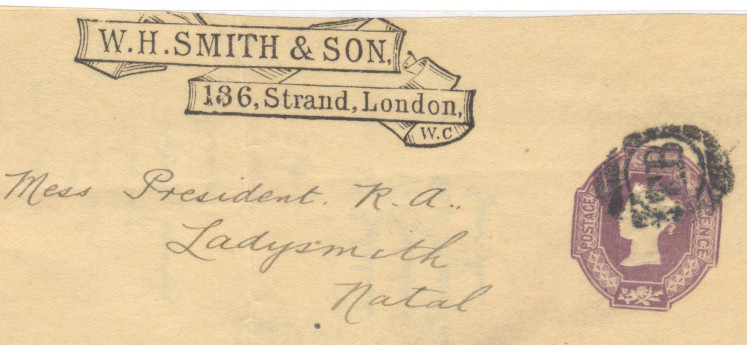
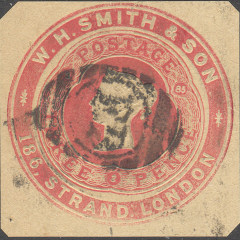
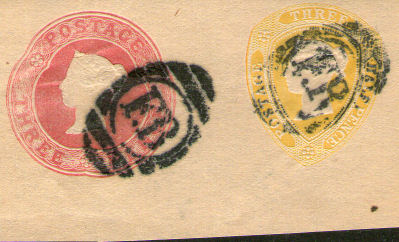
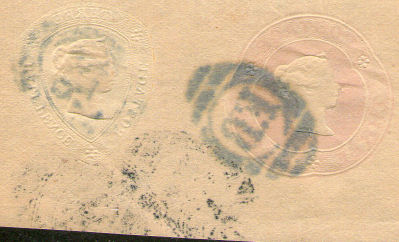
This shows an offset on the back.
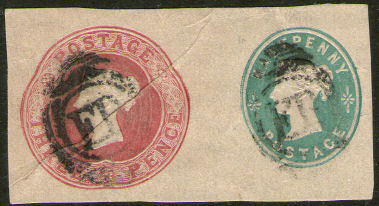
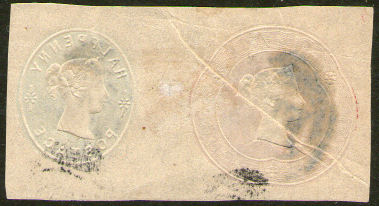
This also shows evidence of an offset on the back.
Considering how often this 'FB' type is seen on W. H. Smith & Son wrappers, it might be expected that some of these are precancels.
However I have found no evidence of it.

The type below is also commonly seen on W. H. Smith & Son wrappers, this one dated 25 Nov 1899. A precancel?
Again, there is no evidence of it


